Sharp FQ8 is a television that offers many advantages that distinguish it in its price class. First and foremost, it is equipped with the Google TV operating system, which provides access to a vast number of applications and a user-friendly interface. The matrix with a refresh rate of 120 Hz ensures high fluidity of the image, and combined with low input lag, makes this model a good choice for gamers. The high native contrast means that blacks are deep and vivid. The television also achieves a decent brightness level of 450 nits, allowing for comfortable viewing of HDR content, especially as it supports advanced formats such as Dolby Vision. The television also offers wide color gamut coverage, thanks to the implementation of quantum dots (Quantum Dot/QLED). On the other hand, Sharp FQ8 has a few drawbacks. The lack of control over dynamic tone mapping in HDR mode may be an issue for more demanding users. Although Dolby Vision IQ is present in this model, it's hard to speak of its positive performance here. Additionally, the matrix response time is average, which can affect the clarity of dynamic scenes, and poor viewing angles mean that watching from the side significantly reduces image quality. Nevertheless, Sharp FQ8 is a great television that combines affordable quality and smooth image at a good price. Although it is not without flaws, it can satisfy most users who are looking for a reasonably priced television with a 120 Hz matrix and a pleasant audio system.
- Matching (Score)
- Our verdict
- TV appearance
- Where to buy
- Contrast and black detail
- HDR effect quality
- Factory color reproduction
- Color reproduction after calibration
- Smoothness of tonal transitions
- Image scaling and smoothness of tonal transitions
- Blur and motion smoothness
- Console compatibility and gaming features
- Input lag
- Compatibility with PC
- Viewing angles
- TV efficiency during daytime
- Details about the matrix
- TV features
- Apps
- Playing files from USB
- Sound
Sharp FQ8 vs Philips PUS8500
Direct compare
PUS8500 / PUS8560 / PUS8510 / PUS8600

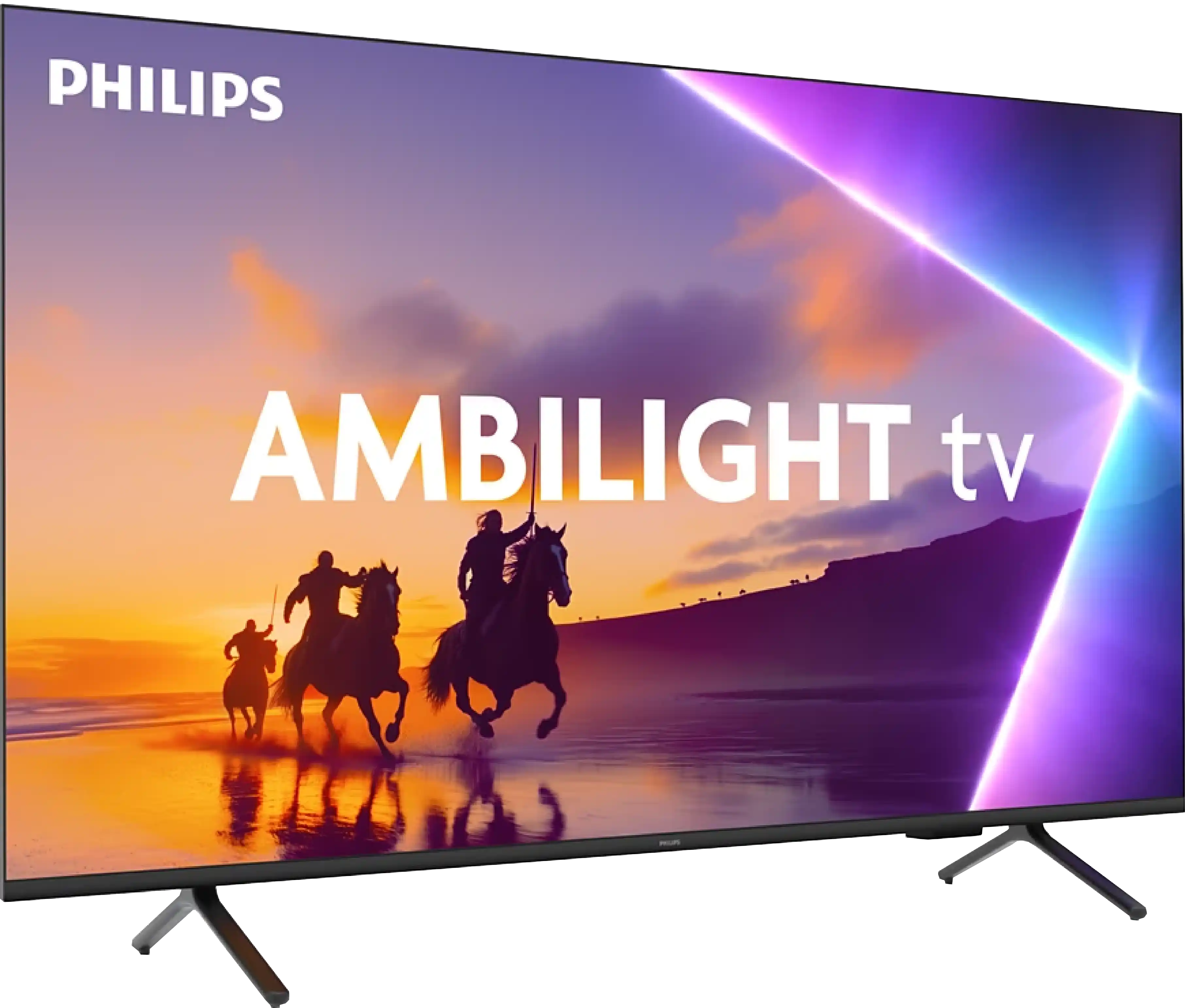
Panel type: LCD VA
Resolution: 3840x2160
System: Google TV
Model year: 2024
Complete the survey to find out the result

Panel type: LCD VA
Resolution: 3840x2160
System: Titan OS
Model year: 2025
Complete the survey to find out the result

Overall rating
6.4
5.6
Movies and series in UHD quality
6.4
5.4
Classic TV, YouTube
6.2
6.1
Sports broadcasts (TV and apps)
6.2
5.2
Gaming on console
7.4
6.7
TV as a computer monitor
3.0
5.6
Watching in bright light
5.4
4.9
Utility functions
6.5
4.9
Apps
9.6
4.6
Sound quality
6.0
6.2
Complete the survey to find out what fits your preferences
Advantages
High native contrast
Smooth tonal transitions
120 Hz panel
Advanced features for gamers
Low input lag
Harman/Kardon signature audio
Ambilight System
High native contrast - VA panel
Low input lag
Basic gaming features: ALLM and VRR
Full support for audio formats: Dolby Atmos and DTS
Backlit remote control with numeric keypad
Disadvantages
Poor viewing angles
Dolby Vision IQ does not work properly
Average panel response time
Poor font readability when connected to PC
Average panel brightness
The TitanOS system seems unfinished (some features do not work, missing applications)
Infrared remote control
Issues with font readability (PC)
Our verdict
Ambilight, as this is what we need to start with, is the biggest reason why it's worth buying the PUS8500. The three-sided backlighting of the television looks fantastic, especially in the evening. It creates an atmosphere, masks contrast shortcomings, and makes watching a film simply more enjoyable. Even if the black levels aren't perfect, the native VA panel offers decent performance at high contrast. Additionally, there’s quite a good input lag and several features for gamers such as ALLM and VRR. Although HDMI 2.1 and a 120Hz panel are absent, playing casually should be a pleasure. Especially since it feels responsive and without delays. Let’s also mention the full support for audio formats – both Dolby Atmos and DTS are included, so soundbar owners can also rejoice.
However, we won't sugarcoat it – this is still a budget television, and at times it’s clearly evident. The brightness is average – not weak enough to prevent viewing, but on an exceptionally sunny day, watching without curtains can be problematic. Nevertheless, in our opinion, the biggest disappointment of the PUS8560 is the Titan OS operating system. Despite the fact that the system debuted some time ago, certain functions simply refused to work – for instance, screen mirroring from a phone despite the manufacturer claiming that such a feature is present. There are fewer apps than in the competition, and the system itself operates rather clumsily. Generally, while it does have some features, it evidently lacks refinement.
Of course, this isn’t a television meant to compete with top models. But if someone is looking for something simple, with a great atmosphere provided by the Ambilight system, it is quite a fair proposition. You just have to know what to expect and accept the numerous compromises present here.
TV appearance




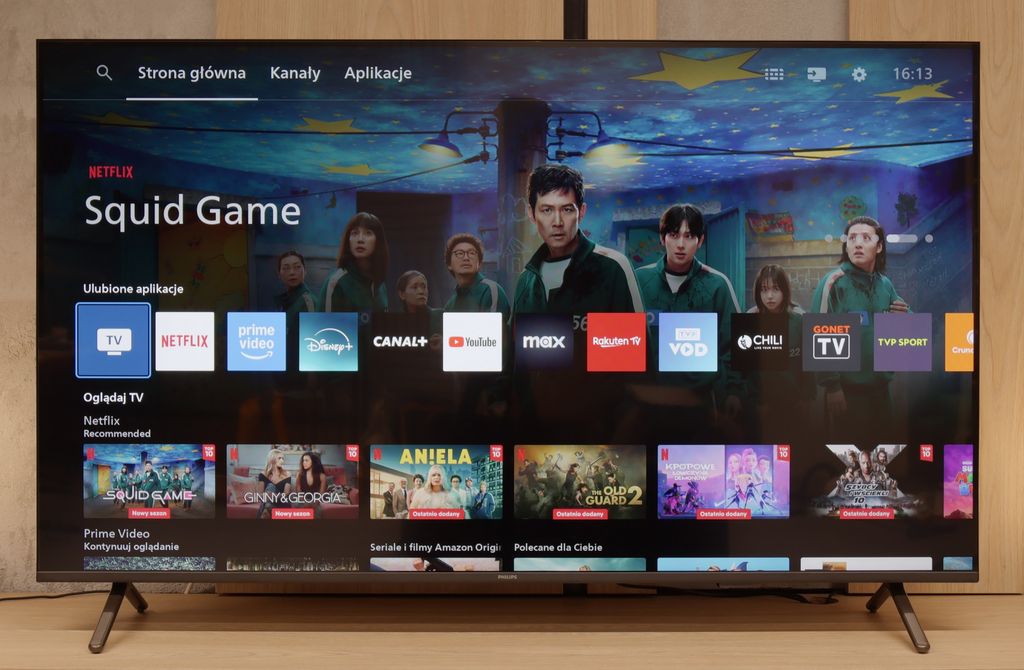
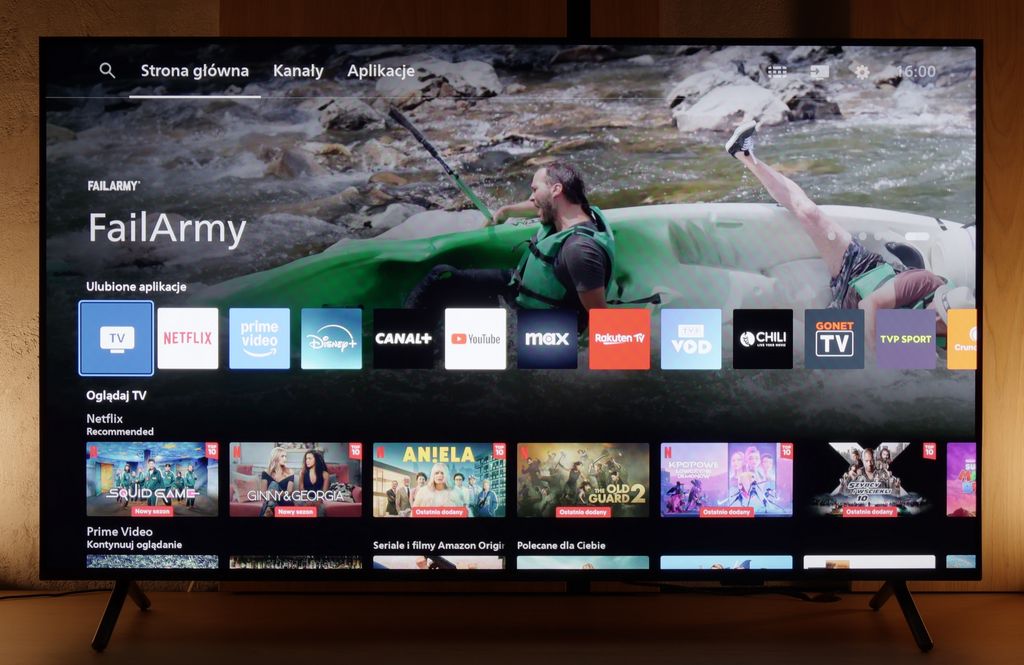
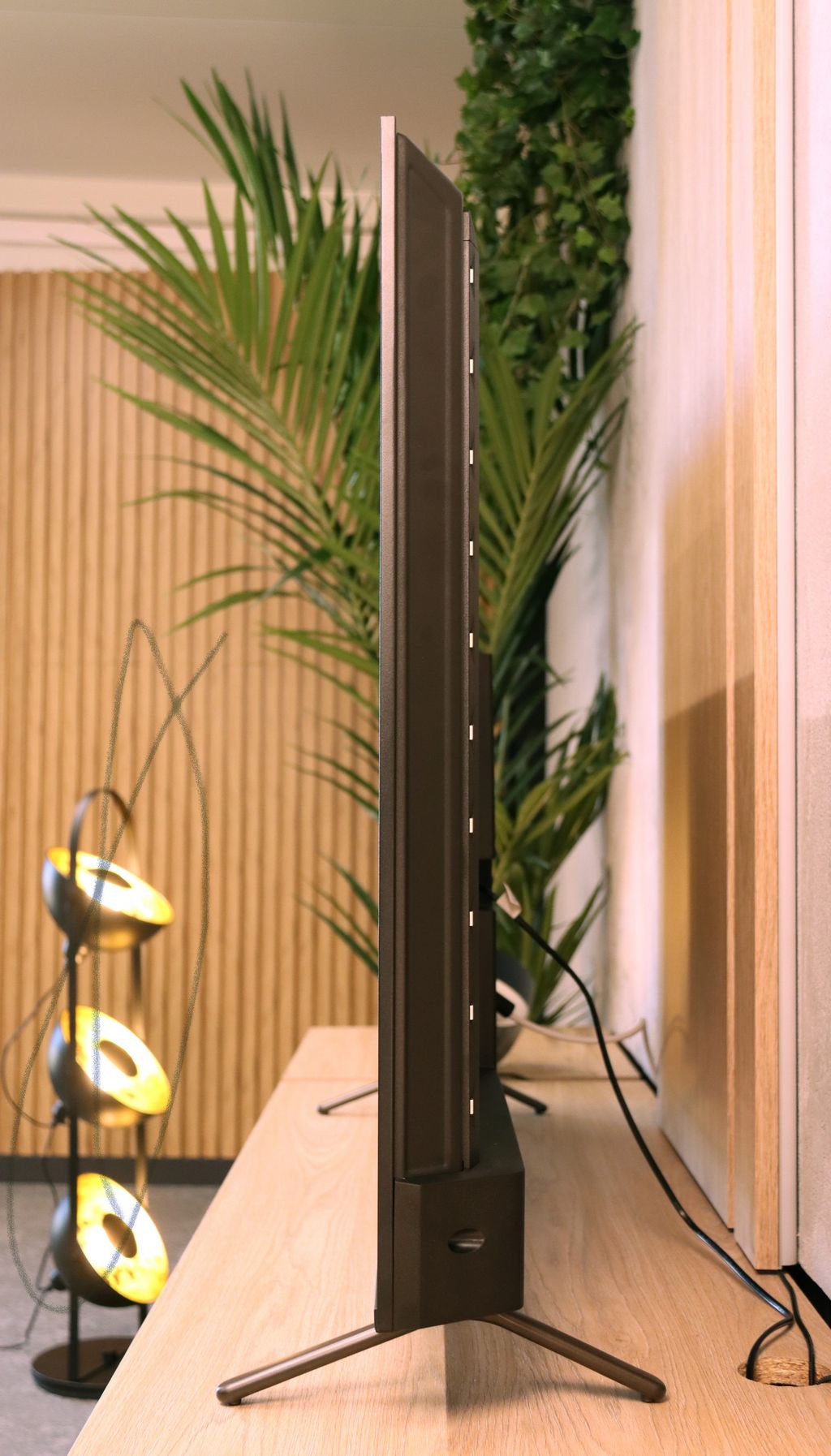
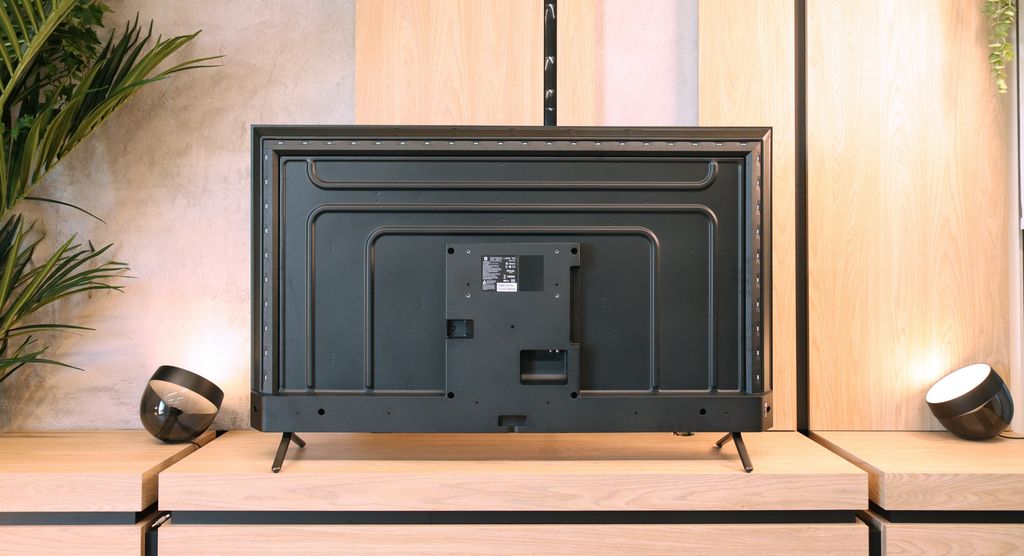
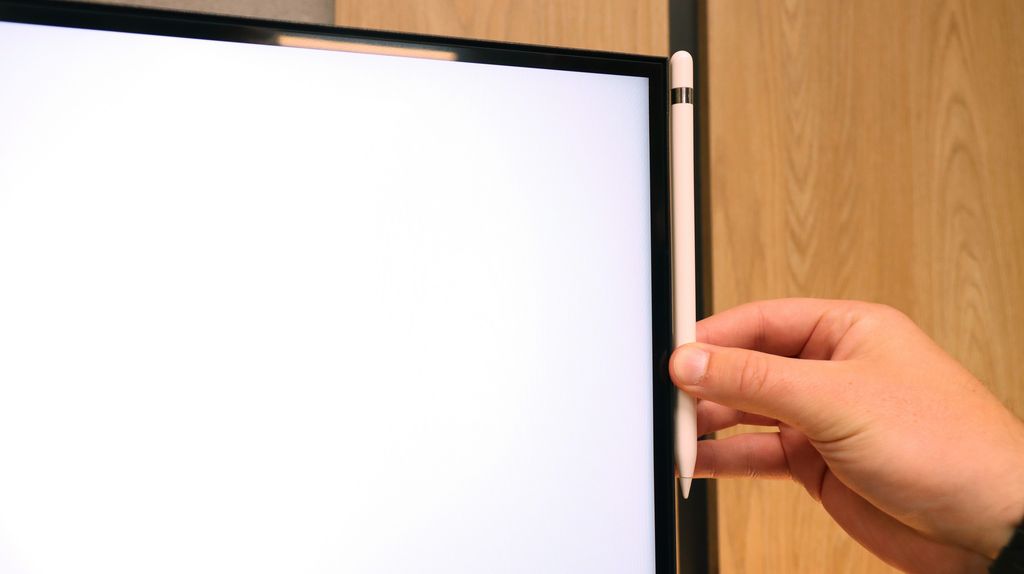
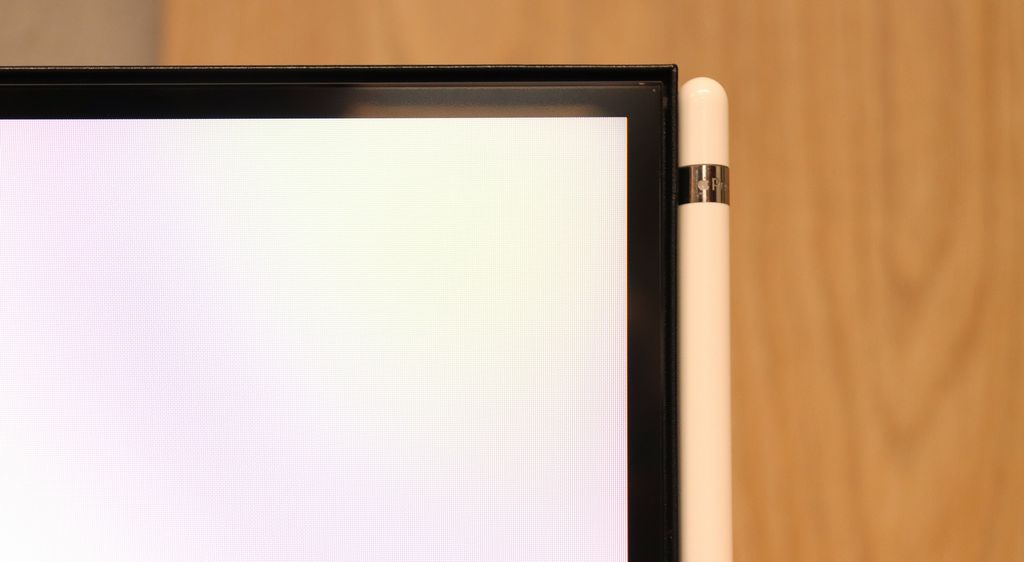

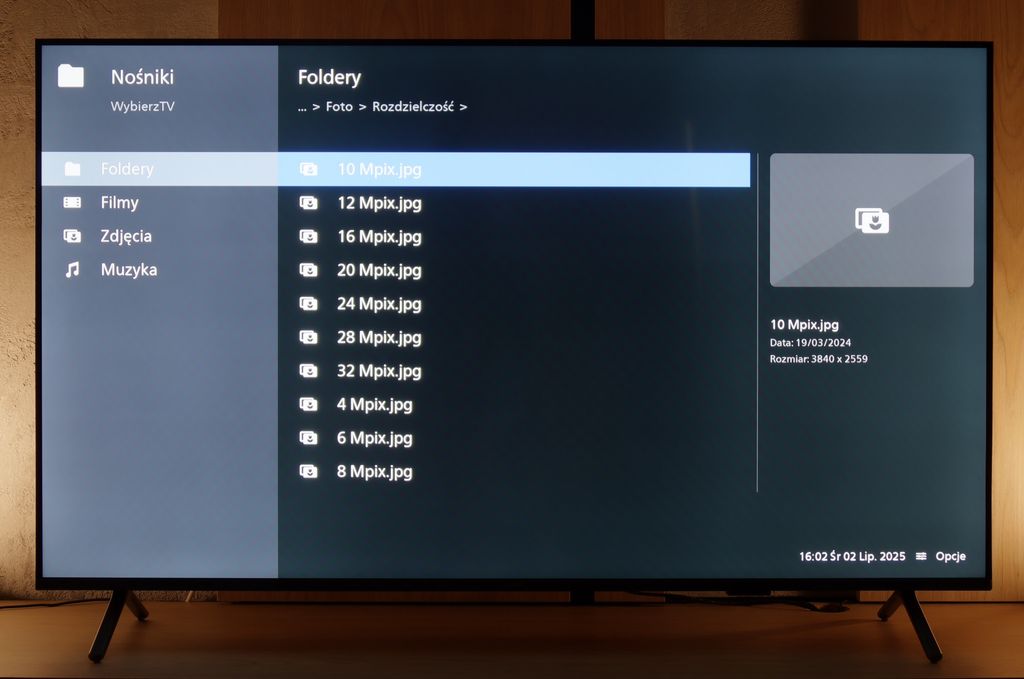
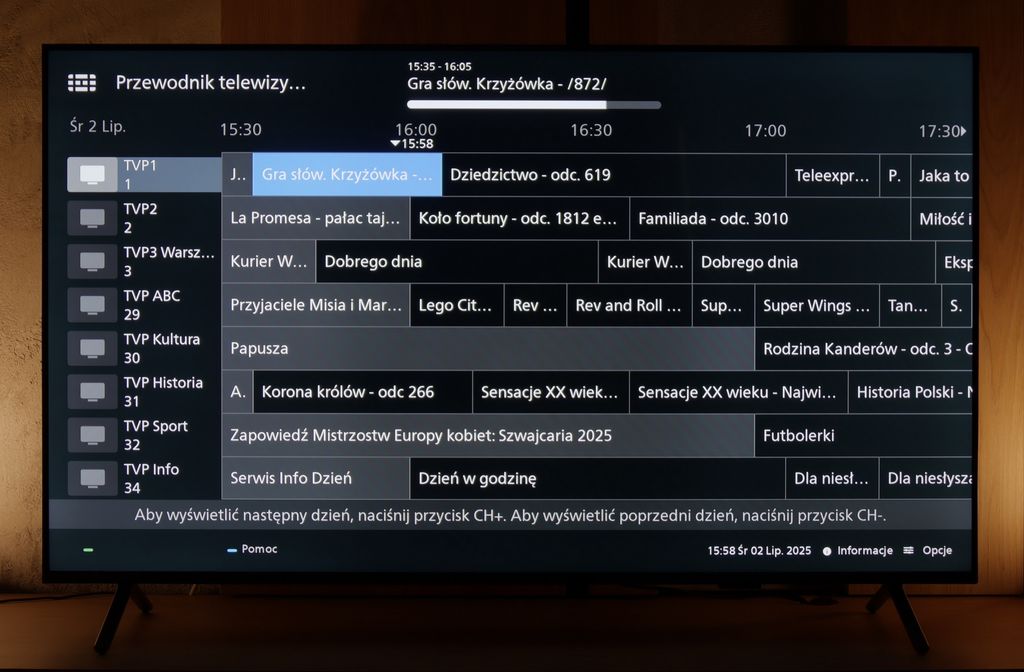
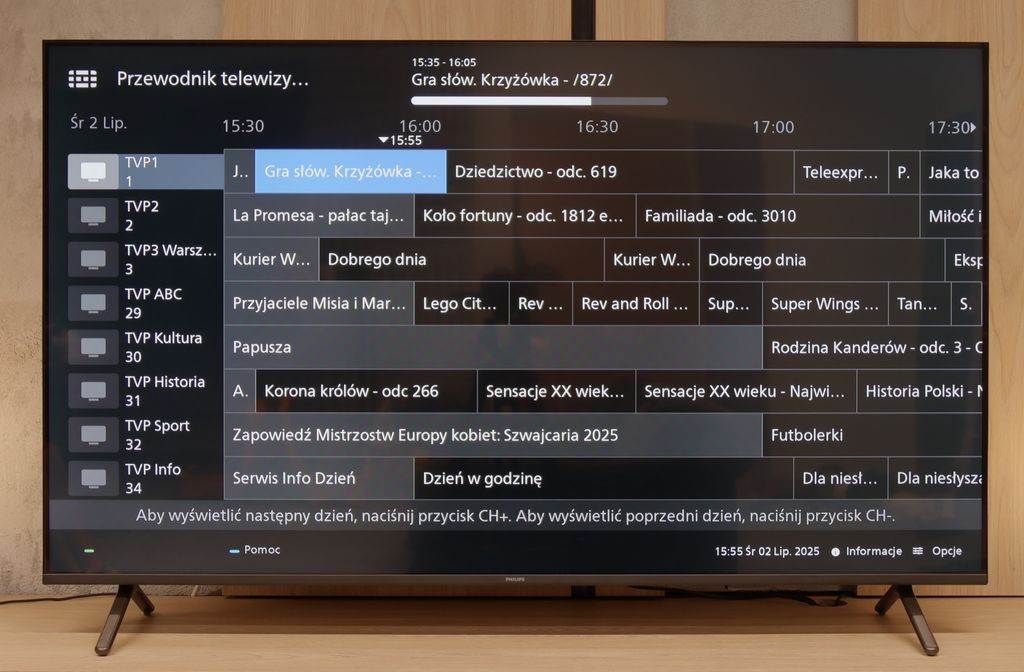
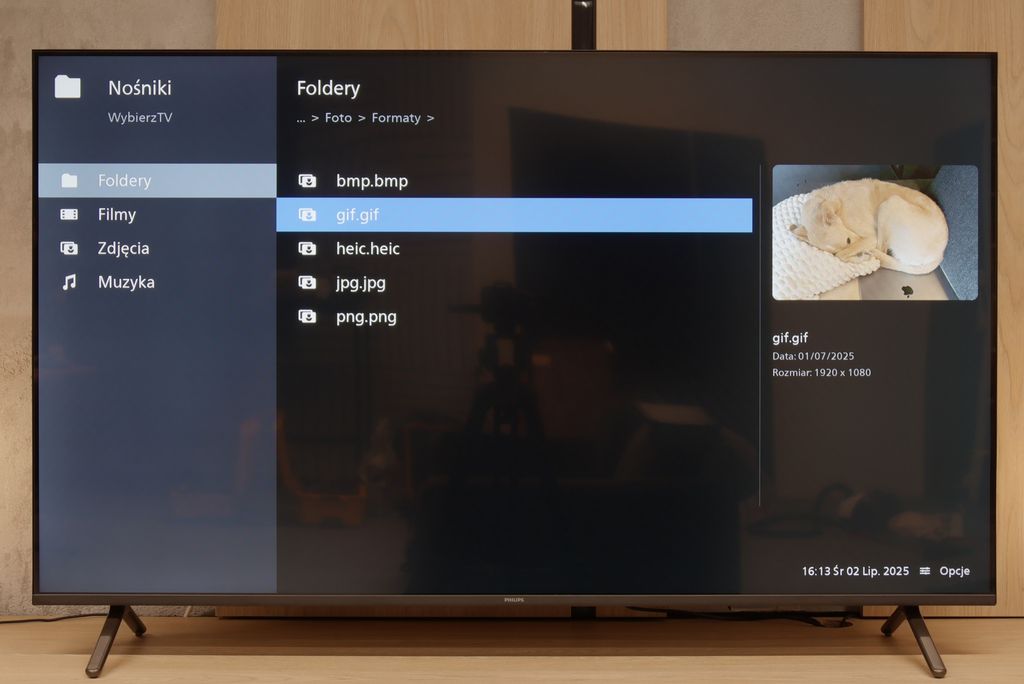
Contrast and black detail
6.2/10
6.1/10
Local dimming function: No
Local dimming function: No
Contrast:

Result
5,200:1

Result
7,200:1

Result
7,700:1

Result
8,100:1

Result
4,800:1

Result
6,000:1

Result
5,950:1

Result
6,250:1

Result
5,950:1

Result
5,750:1
Halo effect and black detail visibility:

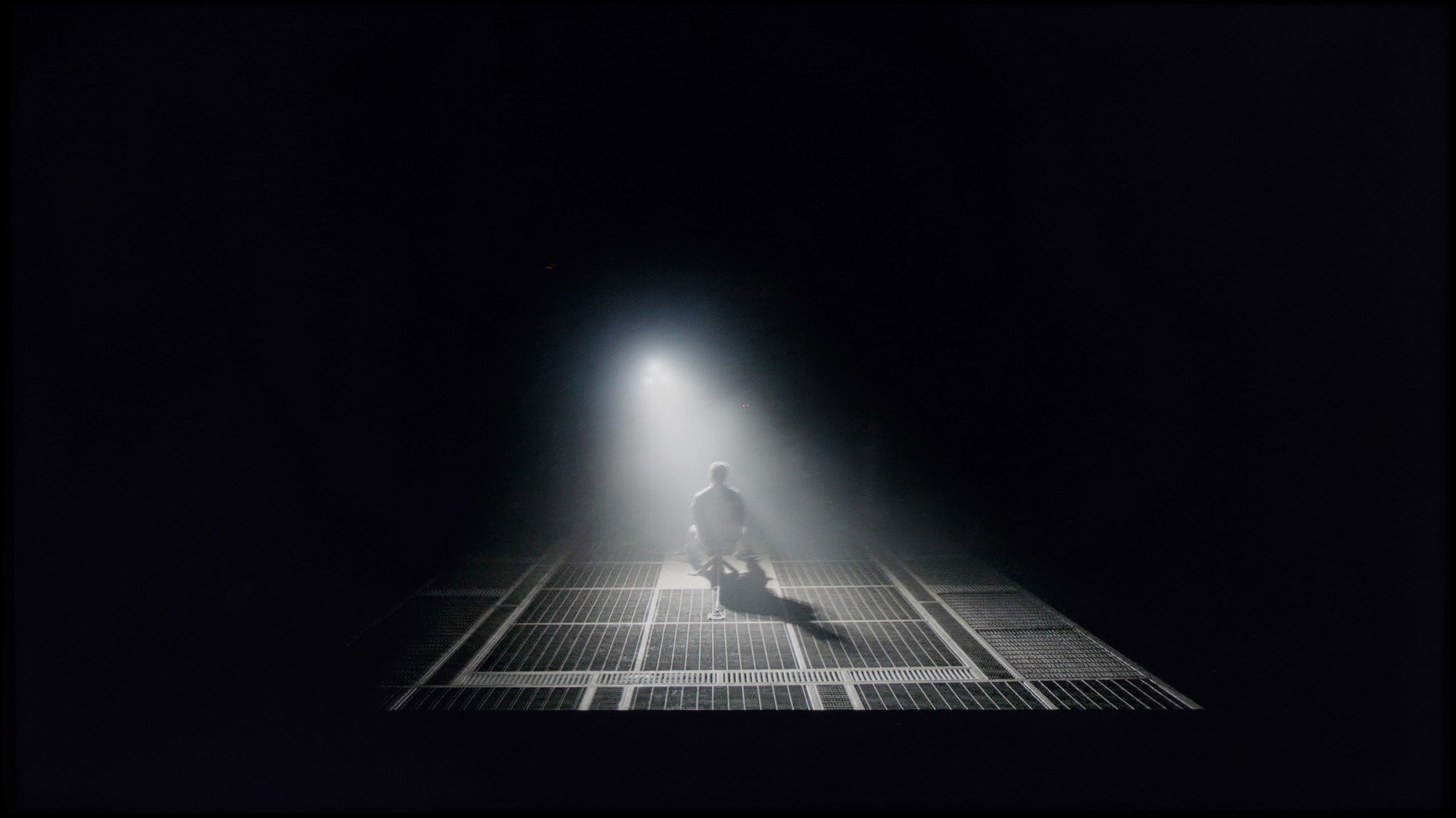
Sharp FQ8, thanks to its VA panel, offers a very high native contrast ratio, achieving an impressive score of 8100:1 in tests with cinematic test patterns. It is worth noting that this result stands out very positively against competing models and is very rarely encountered. This means that the image gains an appropriate depth in scenes with distinct differences between light and dark elements, which is particularly important when assessing contrast and black quality, as these are key criteria in image analysis. The Sharp FQ8 panel uses direct backlighting (Direct LED), however, it does not support local dimming. In this price category, this is understandable, although it affects the depth of black and clarity in darker scenes like that from the film Sicario 2, which can be seen below.
The Philips PUS8560 in the size we tested is equipped with a VA panel. As a result, black levels – as far as LCD televisions go – can be deemed decent. And that is exactly the case with this model. Both black levels and the overall impression of contrast in the film scenes we tested were really quite good – the image does not bleed, and details are visible even in challenging sections.
But the panel alone is not everything. Unfortunately, the PUS8500 does not come with local dimming (which is a given considering the television segment), so one must be aware that in completely dark conditions, the black can resemble shades of navy more than true black. On the other hand – and here’s a plus for Philips – the Ambilight system does an excellent job. The backlighting genuinely affects the perception of contrast. Therefore, even if technically the black is not perfect, subjectively the viewing experience becomes much more pleasurable. For many people, this is enough to make an evening screening truly impressive.
HDR effect quality
5.3/10
4.1/10
Luminance measurements in HDR:

Result
384 nit

Result
399 nit

Result
465 nit

Result
461 nit

Result
463 nit

Result
273 nit

Result
300 nit

Result
324 nit

Result
343 nit

Result
334 nit
Scene from the movie “Pan” (about 2800 nits)


Scene from the movie “Billy Lynn” (about 1100 nits)


Static HDR10


Dynamic: Dolby Vision
Dynamic: HDR10+


HDR luminance chart:
Philips PUS8500
Luminancja HDR
Luminance of RGB colors
Sharp FQ8
Luminancja HDR
Luminance of RGB colors
Sharp FQ8 can achieve a maximum brightness exceeding 450 nits, which is a satisfactory result. Although it may seem that this value is not impressive, it still places it among the top televisions in this price range. In our opinion, this is also a value from which we will feel the richness of the image and the operation of any metadata, which cannot be said about darker devices. The television supports the advanced HDR format known as Dolby Vision. It is also equipped with DOLBY Vision IQ technology, which stands out for its ability to automatically adjust brightness and image colours based on the lighting conditions in the room. Unfortunately, it has been poorly implemented, resulting in significant inaccuracies such as artificial brightening of the image. Therefore, we do not recommend using this technology in this model. Additionally, the colour gamut coverage is around 94% thanks to the use of quantum dot technology, enabling vibrant and realistic colours. This set of features ensures that the image is not only intense but also full of details.
When it comes to the HDR effect on the PUS8560, it can fairly confidently be stated that it is very average. The panel brightness is around 350 nits, which we consider to be the absolute minimum for watching content in this format. However, this is not a result that will astonish a viewer searching for the best possible picture.
On the plus side, it is worth noting that the PUS8500 series – including the PUS8560/12 we tested – is advertised as a QLED television. And indeed, we can expect a wider colour spectrum here. This model is equipped with an additional filter (PFS), and a DCI-P3 colour coverage of around 90% should suffice for the majority of users. This filter works very similarly to quantum dots. As a result, the colours are quite well saturated. It is not an outstanding result, but it is entirely sufficient for watching films and series from streaming platforms.
Factory color reproduction
4.2/10
6.2/10


Factory Mode
After calibration

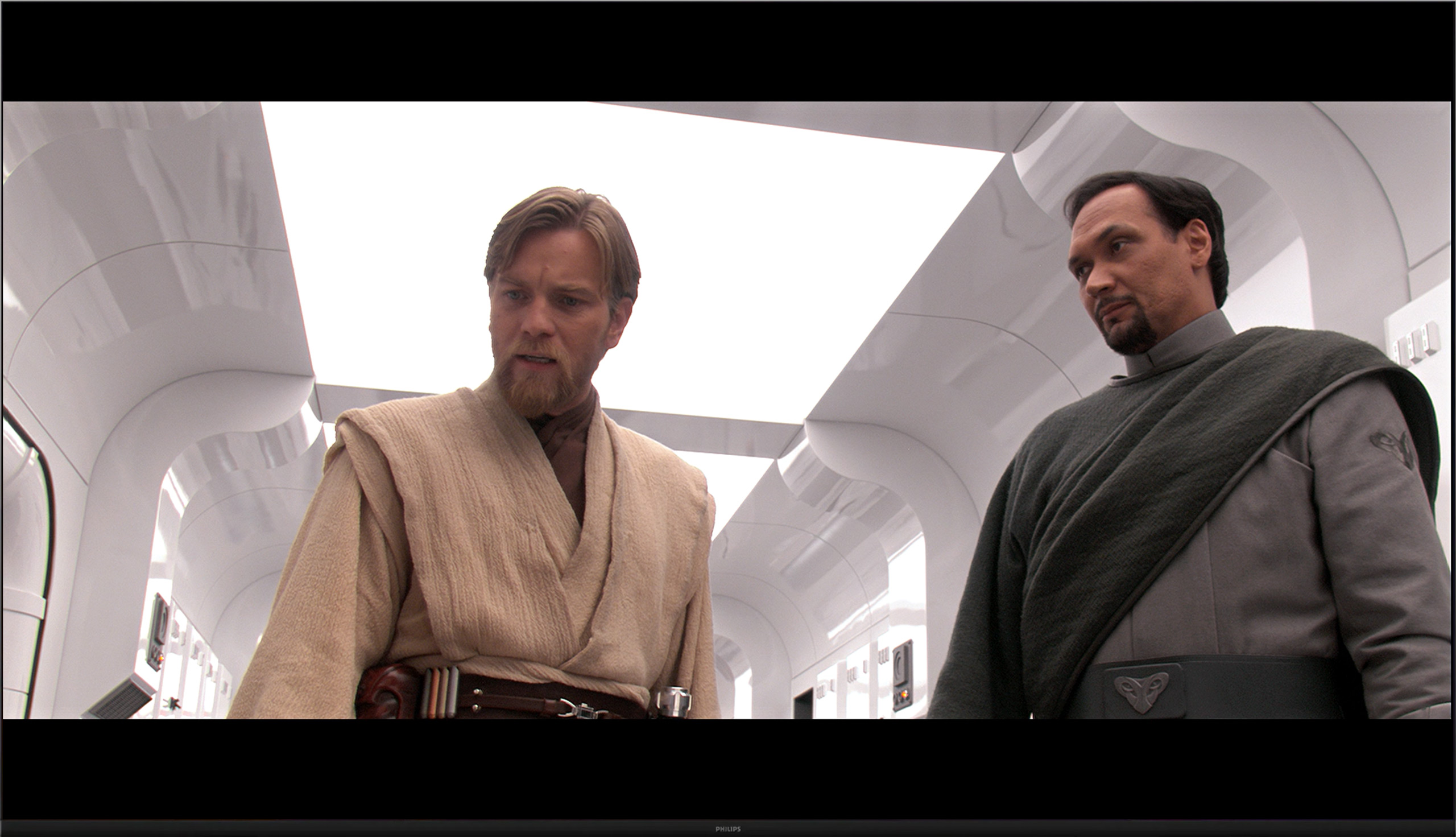
Factory Mode
After calibration
The colour reproduction test in Sharp FQ8 was conducted in film mode, which out of the box offers the best visual capabilities, providing viewers with a colour experience closest to reality. Nevertheless, it cannot be described as exceptional, as there are still some shortcomings that affect the overall picture quality. Colour reproduction in Sharp FQ8 for HD content demonstrates significant issues with white balance. On the graph, the red line clearly rises, indicating excessive dominance of the red colour. This is also confirmed by tests using colour samples, which show that many colours deviate towards red. For example, in a scene from a film featuring a child, the image is very warm and unnaturally red. Similar difficulties occur with 4K HDR content, where there is also noticeable excessive presence of the red colour. It is worth noting this, especially for those who value faithful colour reproduction.
Regarding contrast for SDR, at the beginning of the gamma graph there is a strange characteristic, suggesting issues with reproduction. Subsequently, the entire line is below the reference line, indicating that the television does not achieve appropriate brightness and contrast values in standard content. Meanwhile, the EOTF curve for 4K HDR shows significant discrepancies. Such fluctuations indicate difficulties in maintaining consistent brightness reproduction, leading to unpleasant visual effects when viewing HDR content.
We tested the television with the best available factory settings, namely in Film/Filmmaker mode – this is the mode we recommend for everyday viewing. Unfortunately, it is not without its flaws. Both in HD and HDR content, the image had a noticeable tendency to a pink tint, caused by an excessive amount of red and blue in the white balance. Another issue turned out to be excessive brightness in the image, which was confirmed by both the gamma chart and the EOTF curve. This feature was responsible for loss of detail and washed-out colours in more challenging HDR scenes that we mentioned earlier. The overall result led to significant colour reproduction errors – in extreme cases, the delta E value exceeded 7, while the threshold for visible errors for the human eye is around 3. This situation can be improved with calibration, and you can read about its effects below.
Color reproduction after calibration
7.8/10
8.4/10




After calibration, for SDR content, the white balance on Sharp FQ8 has been significantly improved, and all lines have come much closer to the reference line. Of course, they are not perfectly straight, but it's hard to expect better results from a television in this price range; they are really very good. Improving white balance means that colours are more natural and accurately reproduced, which positively impacts the overall visual experience. In terms of gamma, the strange jump at the beginning of the graph has not been eliminated, however, after this error, the entire line is much closer to the expected effect.
For HDR content, the white balance is somewhat worse compared to SDR content, but it is still significantly better than before calibration. It is worth noting that the improvement in white balance in HDR contributes to a more consistent and pleasant perception of colours, even though there may still be shortcomings. Regarding the EOTF graph and the associated contrast, our specialists noted that the lack of control over dynamic tone mapping settings hindered the achievement of significant improvement in this area. This leads to uneven brightness representation.
Despite the shortcomings resulting from the inability to adjust settings for dynamic tone mapping, Sharp FQ8 has gained a new perspective after proper calibrations. The improved white balance and better colour reproduction in SDR mode make the image more natural and pleasing to the eye. Although there are still areas for improvement, especially in HDR content, the television offers satisfying visual experiences, making it a noteworthy choice in its price range.
The Dutch manufacturer offers quite a sizable amount of settings in its products, so as usual, we decided to tinker with them a bit. The effects are immediately noticeable – we managed to correct the white balance, which made the image stop appearing excessively pink. The brightness characteristic has also been partially evened out, of course, within the limits set by the television itself. The image is no longer overly exaggerated, and the overall reception after calibration is definitely better than in the factory settings of the Filmmaker mode.
One could only critique the EOTF curve characteristic, which still indicates that the image has a tendency to brighten HDR materials. Despite our efforts, the darkest parts of scenes are still sometimes too bright, and the brightest ones do not always achieve their full contrast potential. However, it must be clearly stated that we are dealing with a typically budget construction – one cannot expect reference-level reproduction of HDR content from it.
Calibration has definitely helped this model – it improved the balance, toned down the aggressive colour palette, and brought the image closer to what one might expect from a well-configured movie mode. However, there are certain limitations that cannot be overcome.
Smoothness of tonal transitions
8.8/10
6.3/10





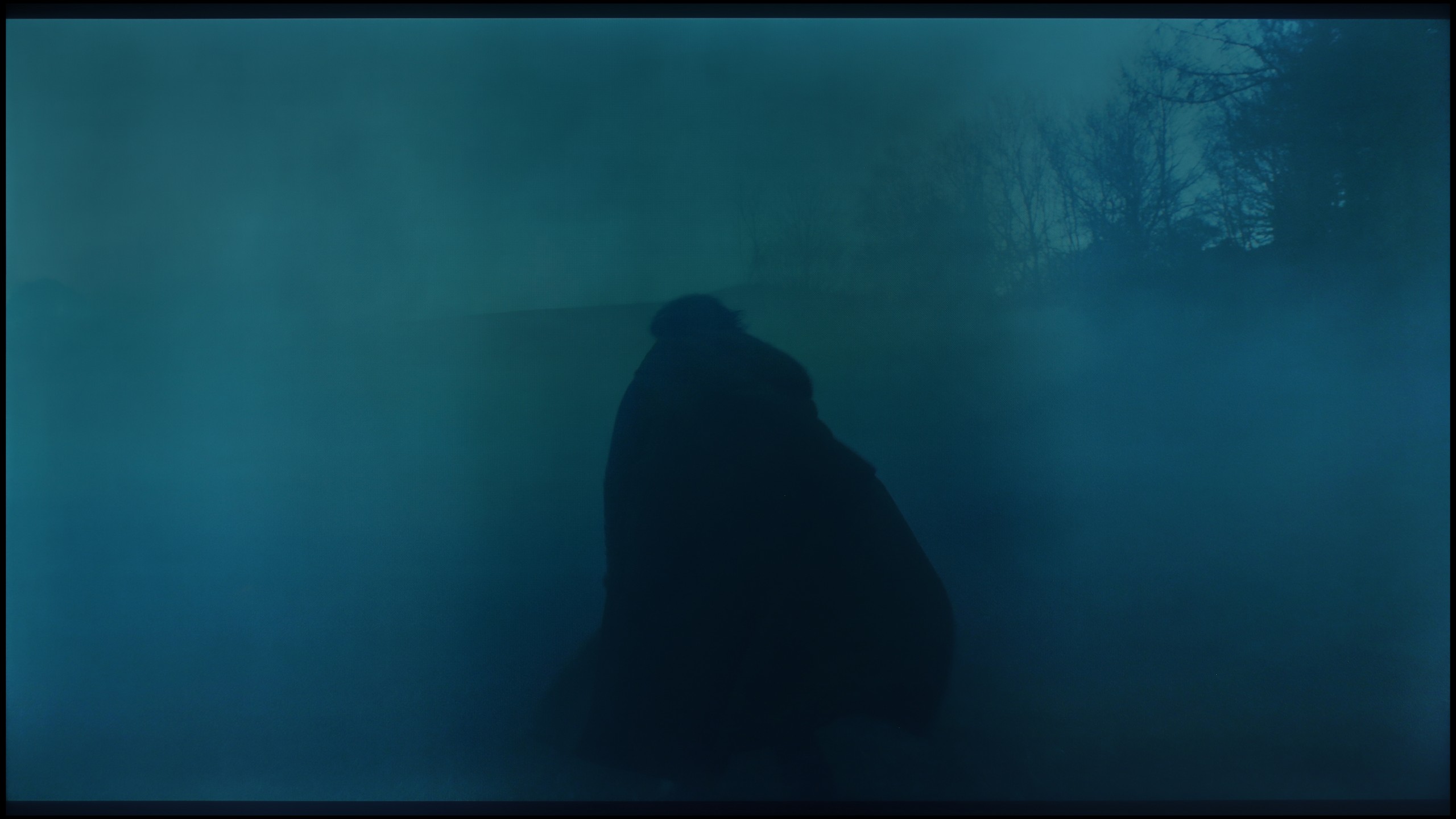

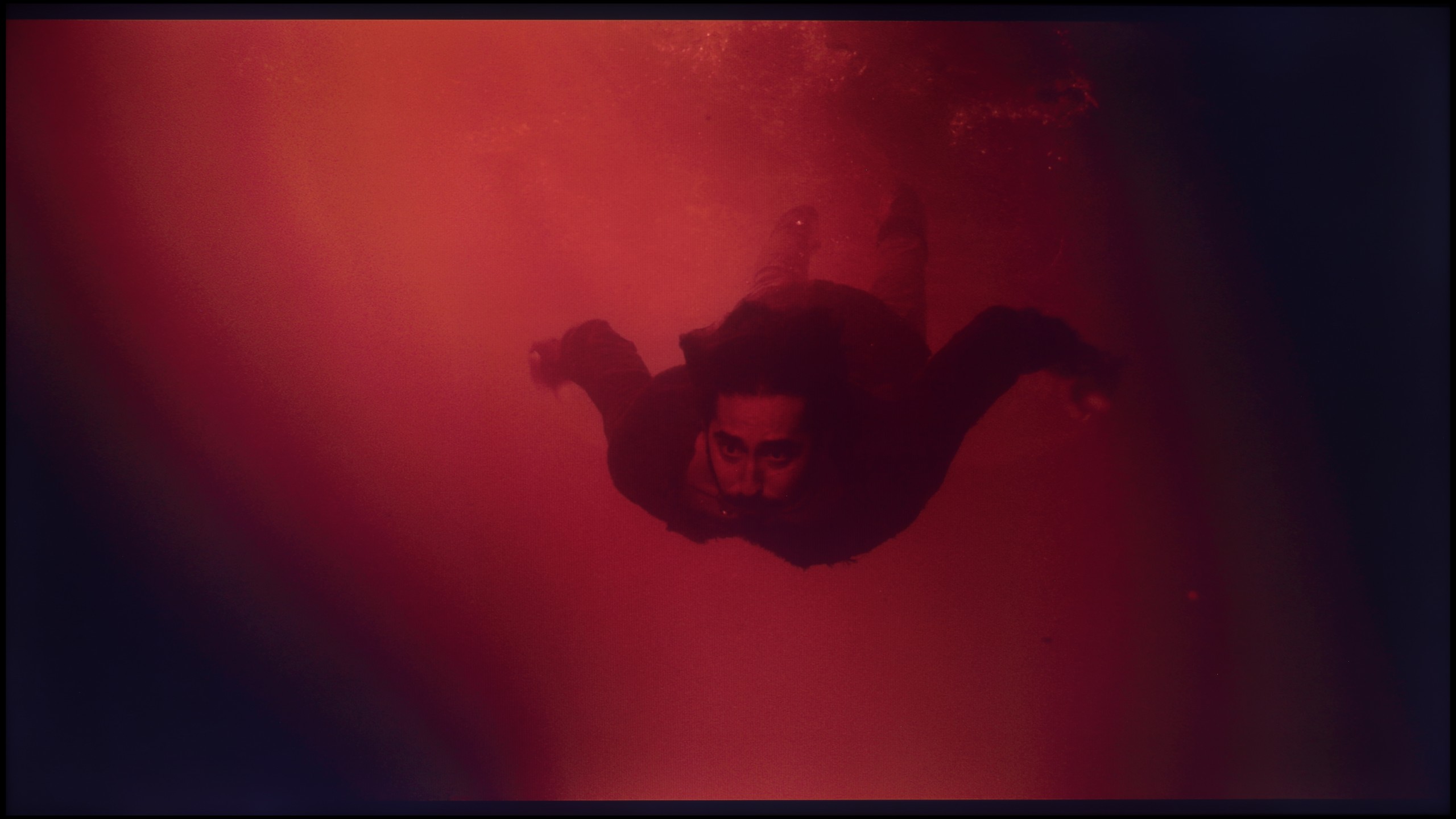




When it comes to the fluidity of tonal transitions, Sharp FQ8 television performs excellently, presenting very nice transitions in all the tested movie scenes. Colours blend harmoniously, which significantly impacts the picture quality. The only aspect that can be pointed out is a slightly noticeable gradation towards black and in the scene with a colourful sunset against the mountains. However, these minor imperfections do not detract from the overall positive visual experience that the television offers.
The PUS8560 handles colour transitions into smooth gradients very well. During tests, the image appeared coherent and natural, and serious issues with tonal transitions occurred only in very dark scenes – for example, in a shot with red water, where subtle cuts between colours could be noticed. However, these are rather exceptions that do not spoil the reception of most content. It is worth mentioning another phenomenon that more significantly affects the quality of the image – the so-called dithering, which refers to a slight "tingling" visible on uniform backgrounds. This effect can be particularly noticeable in high-quality materials and can somewhat spoil the impression of image clarity. It is for this flaw that we deducted some points in our evaluation.
Image scaling and smoothness of tonal transitions
6.5/10
6.1/10
Smooth transition function

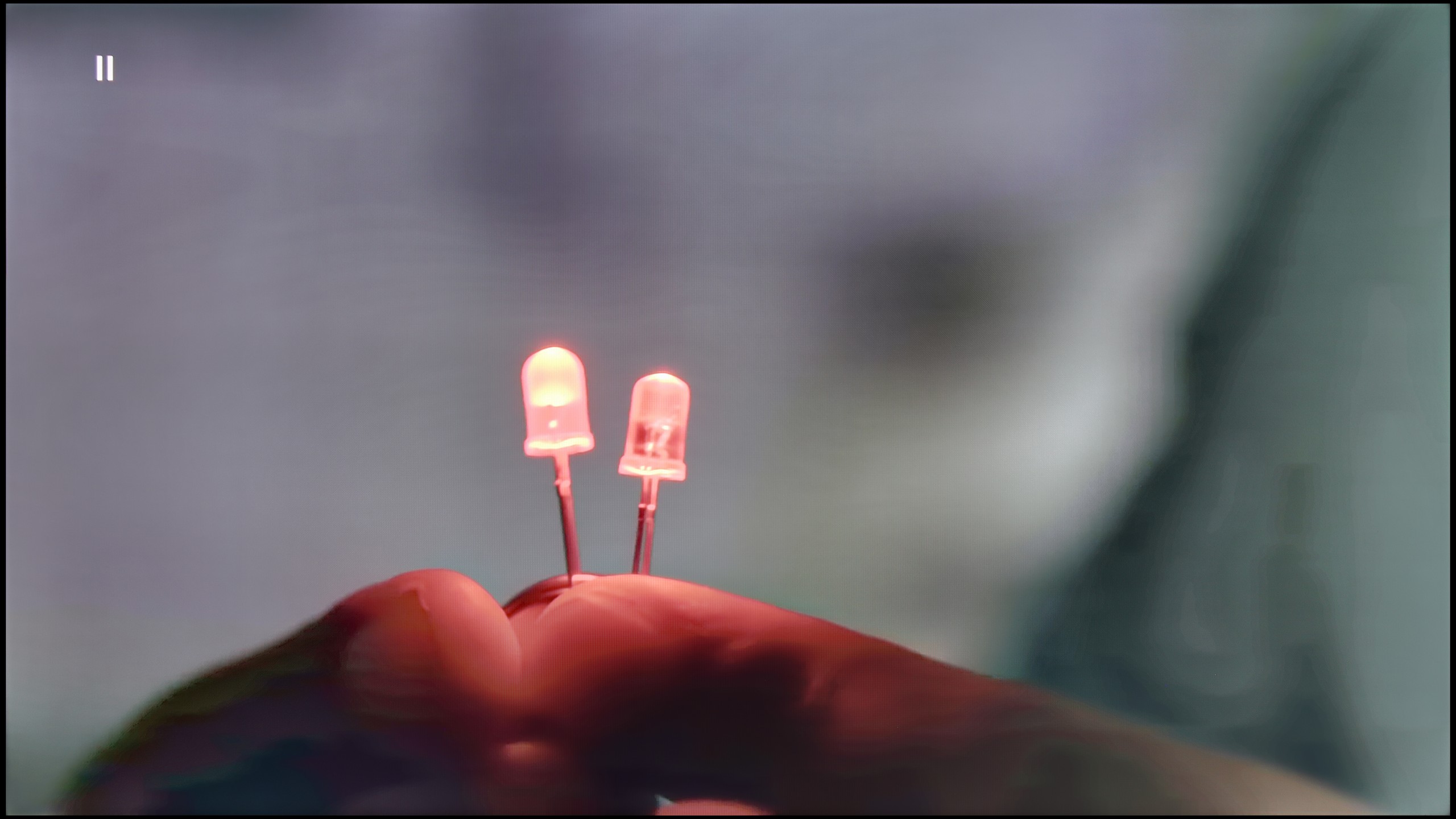
Image without overscan on the SD signal


The "10-bit colour reproduction" feature in Sharp FQ8 performs reasonably well, as we can see in the image with bulbs that shows slight connections between grey shades. For the best results, it is recommended to set medium, which does not reveal issues with grain smoothing or blurring of essential image elements. Alternatively, the "low" setting also proves to be safer and delivers positive effects.
As for upscaling, the Sharp FQ8 television plays back video without overscan, allowing for full use of the screen. The branches shown in the image are noticeably jagged, while the edges of the trousers appear without clear jaggedness, positively affecting the overall image quality. Additionally, the television offers an AI Super Resolution feature, which artificially sharpens jagged elements, enhancing their clarity.
Philips PUS8560 offers a function for reducing posterization, hidden under the name "distortion reduction". And although it indeed fulfills its role by smoothing out problematic tonal transitions, it works a bit too broadly. In practice, it affects not only colourful gradients but also softens faces, the textures of clothing, and the surfaces of furniture. This compromises the authenticity of the image – especially in films where natural texture is very important. However, if someone is looking for smoothing at all costs, it's best to set this option to "Low". For cinema image enthusiasts – we definitely do not recommend it.
On the positive side, the quality of upscaling older materials is noteworthy – the PUS8560 model handles them surprisingly well. The image retains its natural softness, without artificially boosted sharpness. It is also worth mentioning that the television correctly displays content with very low resolution, avoiding issues with image edge cutting (so-called overscan).
Blur and motion smoothness
7.2/10
4/10


Blur (native resolution, maximum refresh rate):





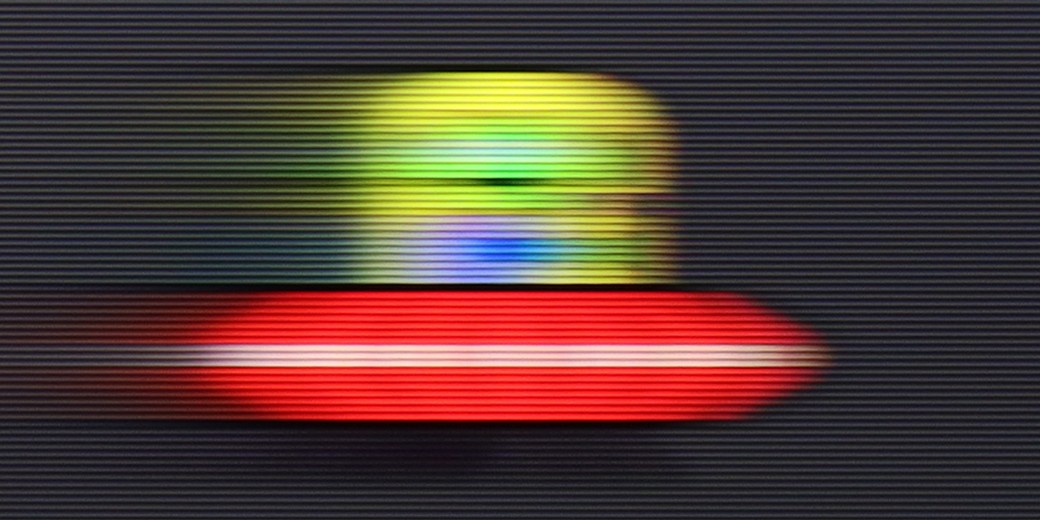
Sharp FQ8 is equipped with a 120 Hz panel, with the possibility of achieving 144 Hz on PC, which in theory should translate to smooth motion rendering. The television offers functions for improving the smoothness of films and reducing motion blur, which is important for more dynamic content. However, the lack of Black Frame Insertion (BFI) technology combined with an average response time of the panel does not yield positive results. The effect is slight blurring of moving objects, and this may be more noticeable when watching sports or during intense gaming.
The Philips PUS8560 is a television equipped with a panel featuring a refresh rate of 60 Hz, which immediately limits its capabilities in terms of displaying dynamic content. Watching sports or playing on a console is not particularly enjoyable. The situation is further worsened by the lack of any option to improve the smoothness of films. In the menu, we won't find settings that would allow us to enable a motion smoother or even a slight motion smoothing for films recorded at 24 frames per second. You can imagine the effect. The image can appear jerky, especially in shots with panoramic camera movements.
Console compatibility and gaming features
7.1/10
4.7/10
- ALLM
- VRR
- VRR range48 - 144Hz48 - 60Hz
- Dolby Vision Game Mode
Yes, high input lag
- Correct implementation of HGIG
- 1080p@120Hz
- 1440p@120Hz
- 4K@120Hz
- Game bar

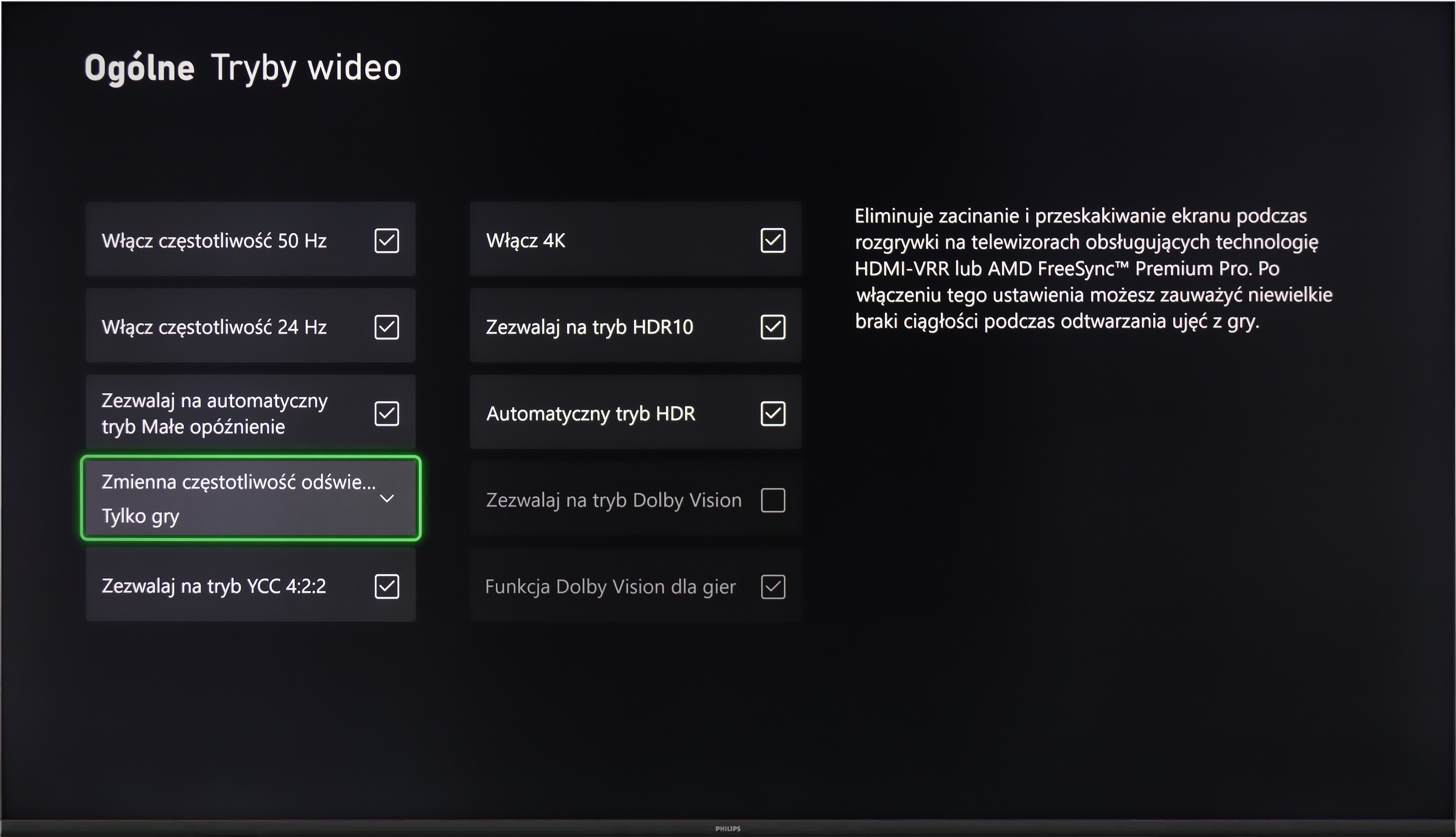

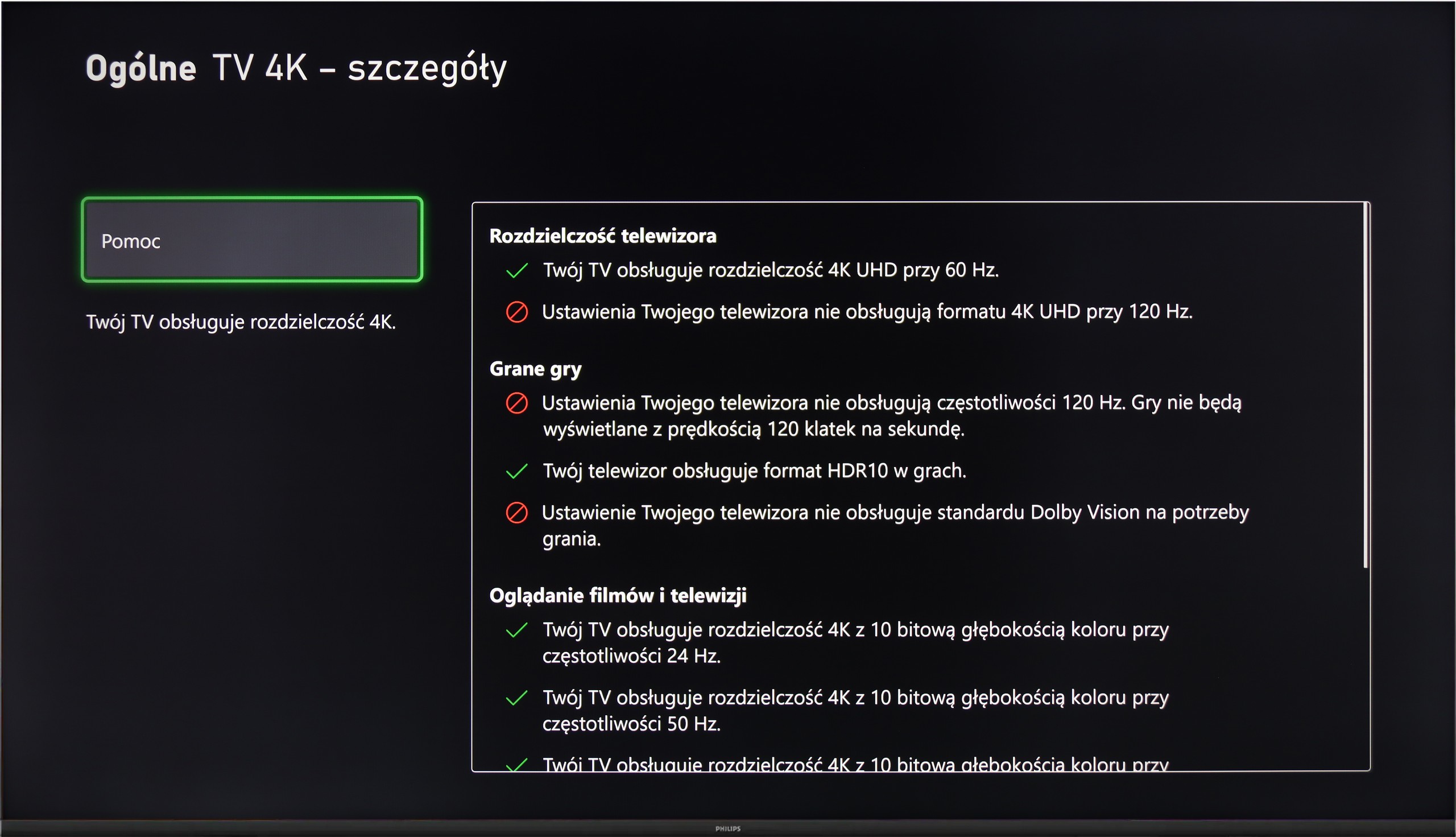

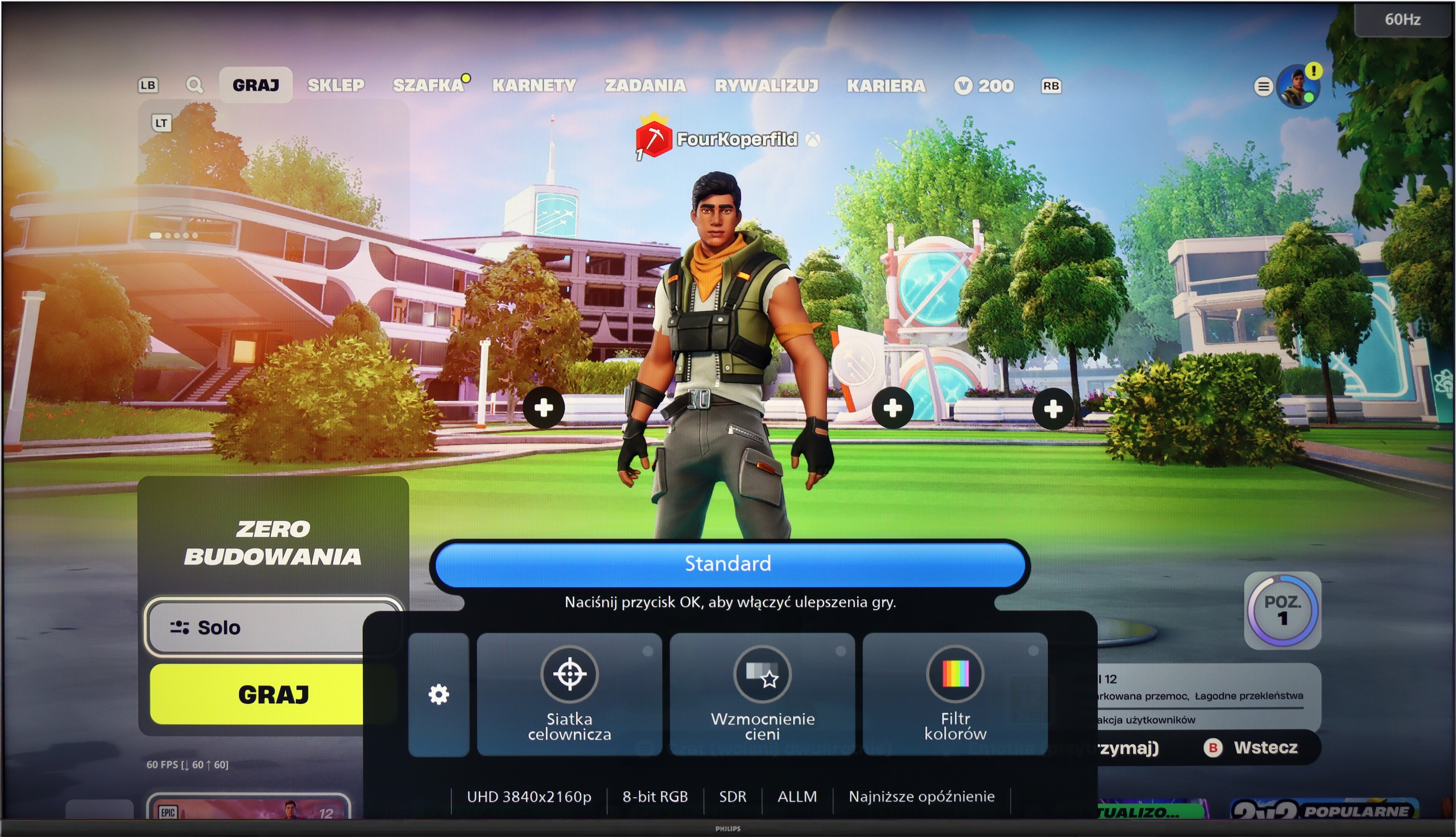

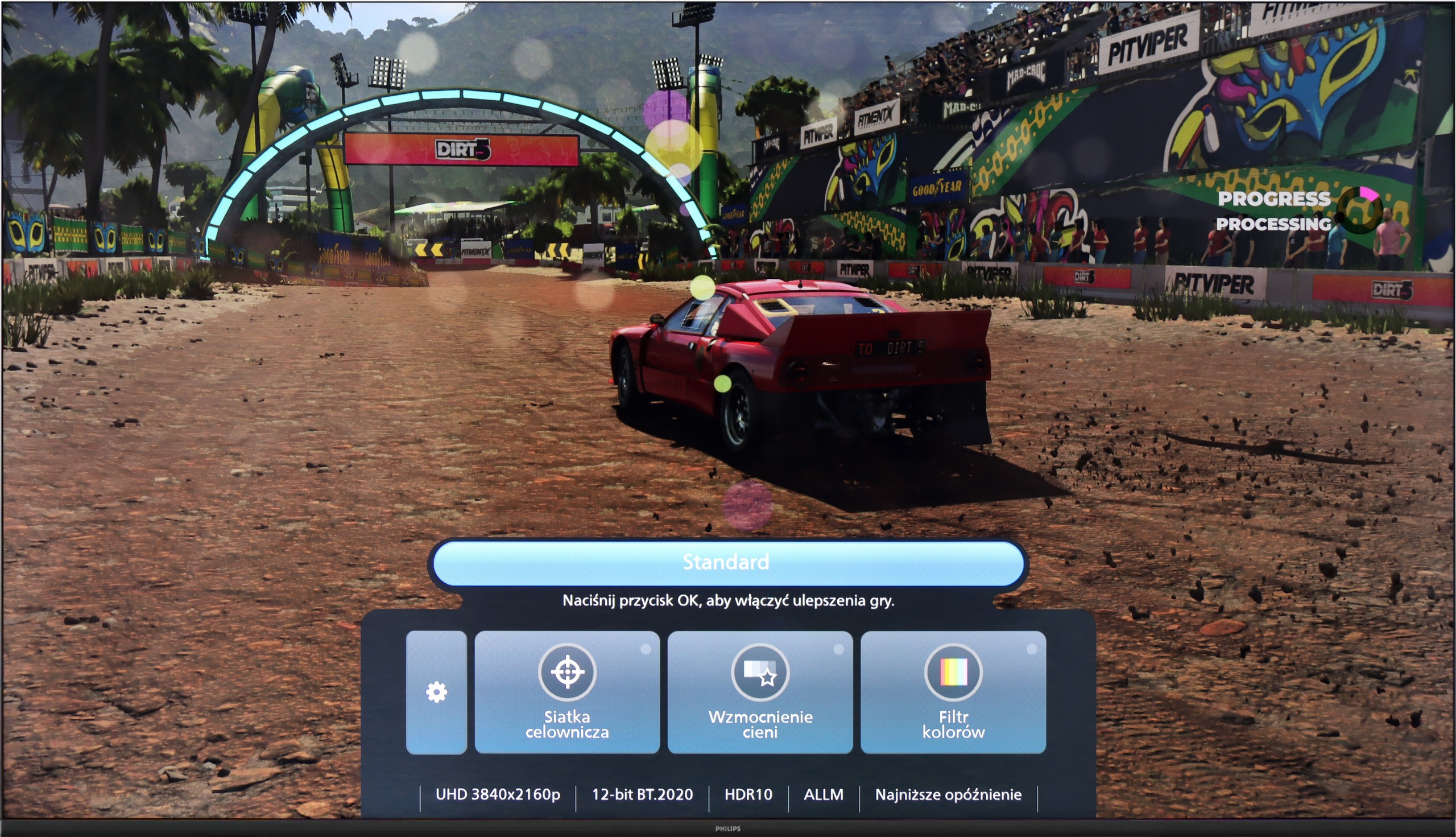
Sharp FQ8 offers several significant features dedicated to gamers that can enhance the gameplay experience. First and foremost, the television is equipped with HDMI 2.1, which comes with certain advantages. ALLM (Auto Low Latency Mode) switches the television to a mode with minimal input lag when a gaming device is detected. VRR (Variable Refresh Rate) reduces screen stutter by adjusting the refresh rate to the number of frames generated by the console or computer, providing smoother experiences, especially in dynamic games. Additionally, the television supports G-Sync technology, which synchronises the image with the graphics card, eliminating stuttering and screen tearing. Despite these advantages, FQ8 also has some limitations. The lack of support for HGiG (HDR Gaming Interest Group) means that the television does not optimise dynamic range for HDR games. The Dolby Vision mode, although theoretically offering better image quality in games supporting this format, suffers from very high input lag.
Although the Philips PUS8560 is not designed with gamers in mind, the manufacturer has decided to equip it with a few features that may prove useful when connecting a console. On board, we find automatic switching to game mode (ALLM), as well as a simple connection status information bar – the so-called Game Bar. It does not make a particularly strong visual impression, but it serves its purpose. The presence of variable refresh rate (VRR), operating in the range of 48 to 60 Hz, may come as a surprise. While this is not a wide range, in the case of less demanding games or titles with unstable frame rates, VRR can help reduce screen tearing. However, this is the only element that could be considered beyond the minimum.
It must be made clear that the PUS8560 is not equipment for gamers looking for a responsive screen and full support for modern console features. It lacks HDMI 2.1 ports, the refresh rate is limited to 60 Hz, and the response time of the panel is not among the fastest. This model may be suitable at most for casual gamers who want to enjoy the Ambilight system.
Input lag
9.1/10
10/10
SDR
HDR
Dolby Vision
Generally, the input lag in Sharp FQ8 is very good, achieving below 16 ms for each tested resolution, making the television suitable for gaming, providing smooth and quick response. However, when Dolby Vision mode is enabled and the refresh rate is 60 Hz, the input lag increases sharply. This significantly worsens responsiveness, which can be particularly troublesome in dynamic games where precision and speed of reaction are crucial.
The input lag on the PUS8560 is very good. When we previously mentioned that this screen is rather for the "casual gamer," there is nothing to be ashamed of in this regard – even when compared to screens aimed at gamers. Results around 12 ms are truly outstanding, allowing for an enjoyable responsive gameplay experience. It doesn't matter whether we are playing in Full HD or 4K – the lag remains equally low, so if you value a quick response time, the PUS8560 will definitely not disappoint in this aspect.
Compatibility with PC
3/10
5.6/10

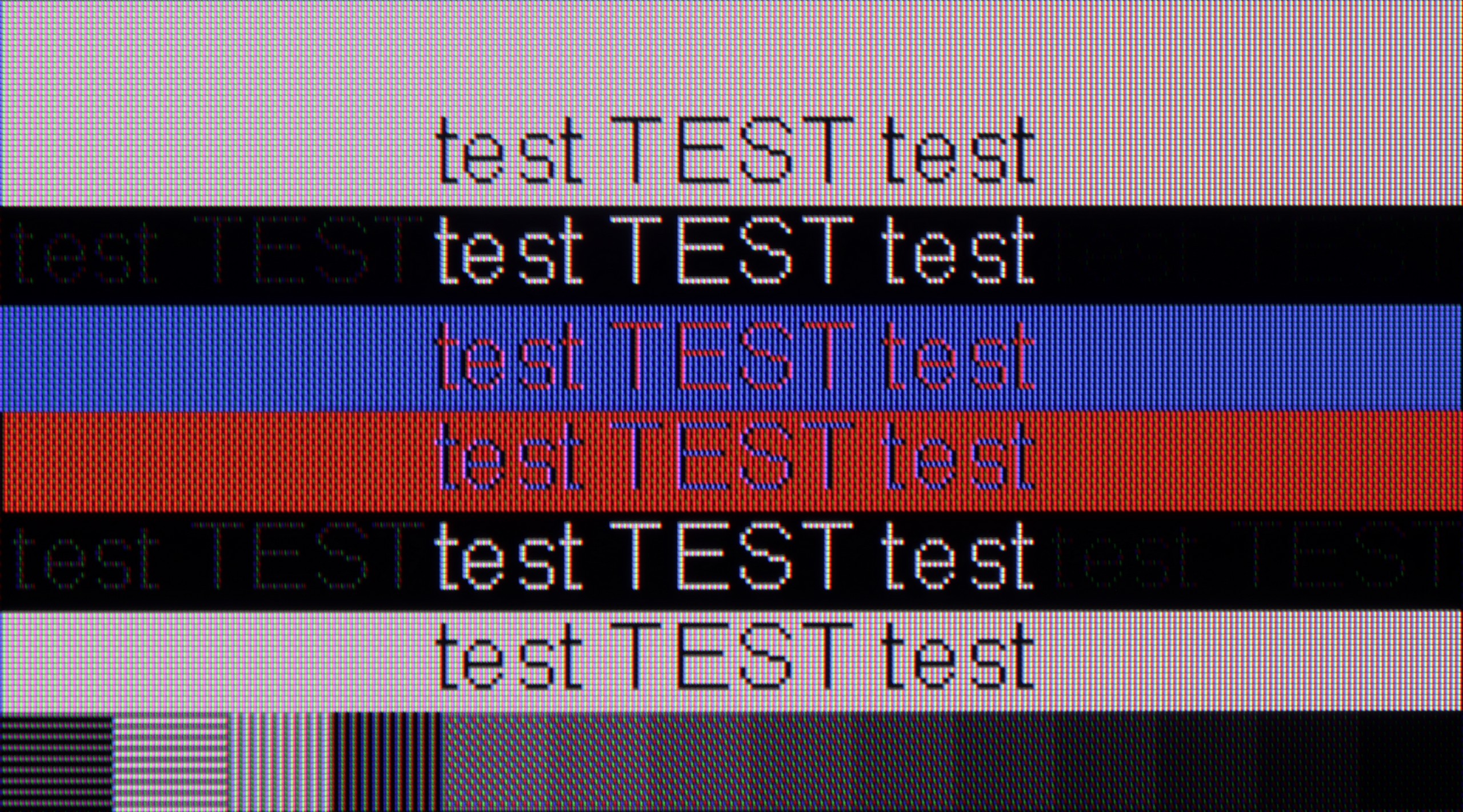
The cooperation of the television Sharp FQ8 with the PC unfortunately leaves a lot to be desired, despite the low input lag. The main problems arise from the lack of full support for chroma 4:4:4 at a resolution of 4K and 120 Hz, which results in blurry text and details in computer graphics. Additionally, the applied subpixel arrangement of BGR, instead of standard RGB, makes fonts less readable and can appear fuzzy.
When it comes to working with a PC on the PUS8560, it looks... quite strange. Chroma 4:4:4 is present in "Monitor" mode, but there is a problem with grey fonts – not all subpixels are lit, which results in the text appearing jagged. On the other hand, in "Game" mode – chroma 4:4:4 disappears, but the grey fonts look correct. In practice, we are therefore forced to juggle settings if we want to have perfectly readable text at all times. And what about gaming on the computer? Our opinion remains the same as for consoles – it is doable, but without fireworks. There is no variable refresh rate for G-SYNC graphics cards, and the refresh rate itself remains relatively low. However, we can once again highlight the very low input lag, which saves the situation in dynamic games.
Viewing angles
2.1/10
3.3/10
The viewing angles on the Sharp FQ8 are quite poor, which is a result of the use of a VA panel. When watching from a wider angle, the television significantly loses brightness, and colours quickly lose their saturation. As a result, the image becomes washed out, and details less clear, which can be problematic if you plan to watch television with a larger group or from different positions in the room.
The viewing angles on the PUS8560 are precisely what one would expect from a VA panel - it's not the best. The image loses quality even with a slight shift off-axis – colours become washed out and black begins to resemble a dark navy. This is, of course, the price paid for the better contrast that VA offers when viewed directly. In the case of our 55-inch model, this is still acceptable, especially if the television is positioned perfectly opposite the sofa. However, with larger screen sizes or a less central placement in the living room – it could become a problem for comfortable viewing.
TV efficiency during daytime
5.4/10
4.9/10

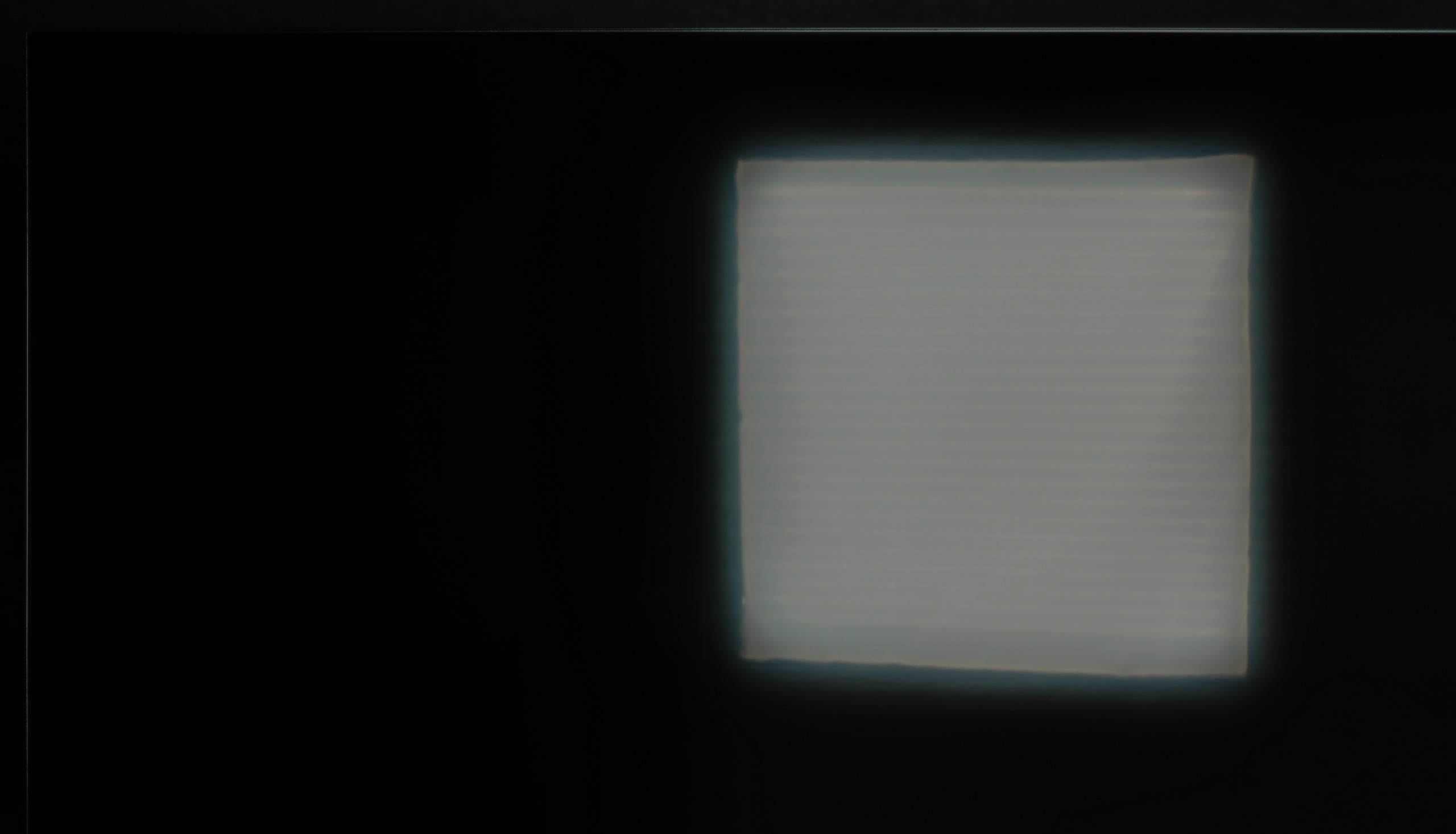

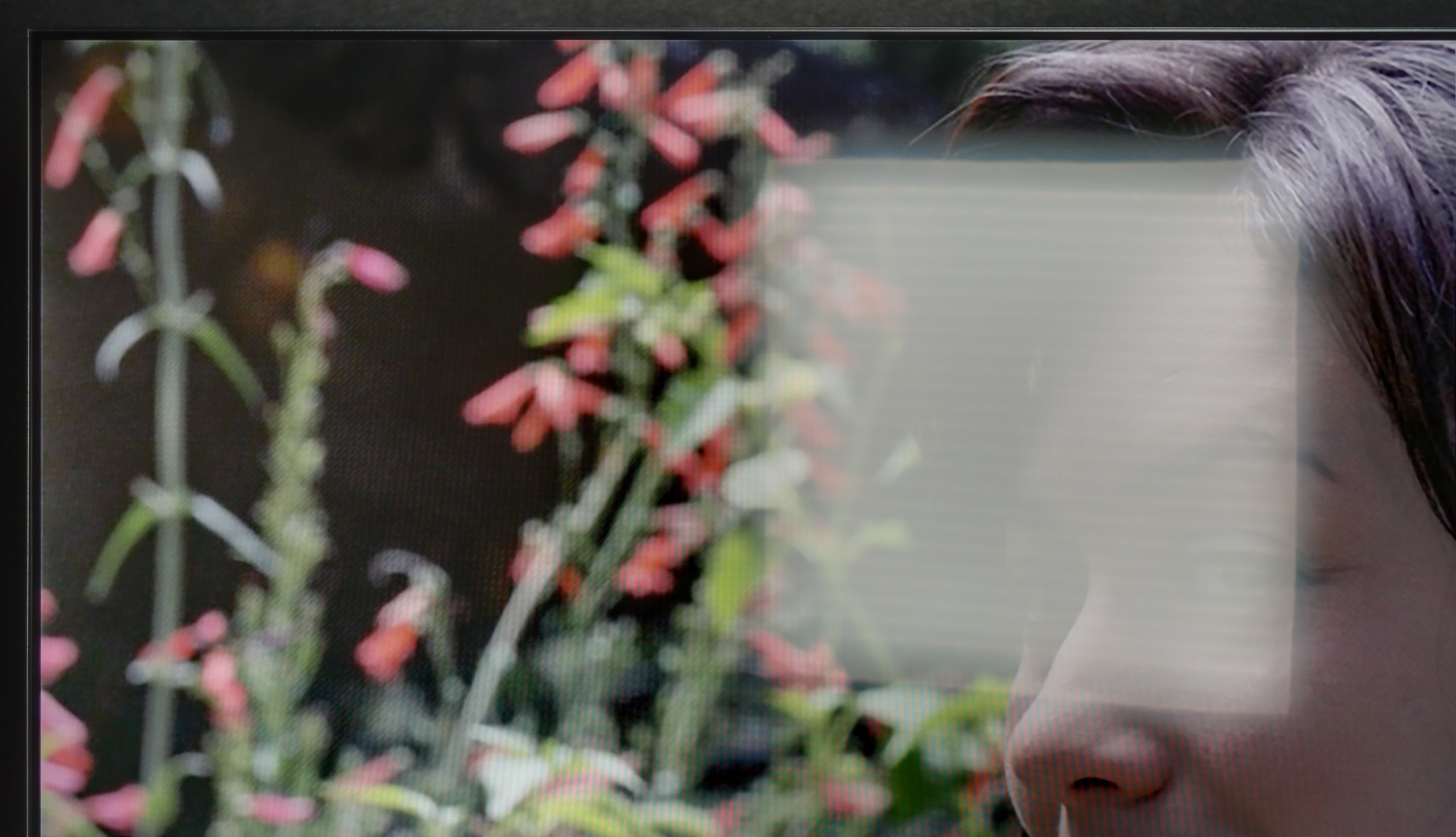
Matrix brightness
Average luminance SDR
Philips PUS8500 : 331 cd/m2
Sharp FQ8: 440 cd/m2
Sharp FQ8 performs quite well in daytime lighting conditions. The panel reaches a brightness level of 440 nits, which, combined with the satin screen coating, results in satisfactory visibility even in bright light. Importantly, the television does not have issues displaying the colour black during the day, which ensures that darker scenes remain readable and do not lose depth, despite the bright surroundings.
The PUS8560 performs moderately during the day. The satin matrix coating quite effectively dampens reflections, which means that light from windows or lamps does not interfere too much. The blacks also look decent for a VA panel – even in daylight, there are no significant losses in contrast. However, all the charm fades when it gets really bright. The panel's brightness is around 300 nits, which is definitely too little to speak of full comfort in a heavily lit room. In such conditions, the PUS8560 simply needs to be aided by blinds – otherwise, the image begins to look rather pale.
Details about the matrix
Subpixel Structure:

Panel uniformity:
Sharp FQ8
Philips PUS8500
TV features
6.5/10
4.9/10
- HDMI inputs2 x HDMI 2.0, 2 x HDMI 2.1 48Gbps3 x HDMI 2.0, 0 x HDMI 2.1
- Other inputsRCA (Chinch)
- OutputsToslink (Optical audio), eARC (HDMI), ARC (HDMI), Mini-Jack (Headphones)Toslink (Optical audio), eARC (HDMI), ARC (HDMI), Mini-Jack (Headphones)
- Network InterfacesWi-Fi 2.4GHz, Wi-Fi 5GHz, Ethernet (LAN) 100MbpsWi-Fi 2.4GHz, Wi-Fi 5GHz, Ethernet (LAN) 100Mbps
- TV receptionDVB-T, DVB-T2, DVB-S, DVB-S2, DVB-CDVB-T, DVB-T2, DVB-S, DVB-S2, DVB-C
Classic features:
- Recording to USB (terrestrial TV)
- Recording programming
- Picture in Picture (PiP)
- RF remote control (no need to aim at the screen)
- Backlit remote control
- Teletext
- Audio only mode
- Possibility to connect Bluetooth headphones to the TV
- Possibility to simultaneously use Bluetooth headphones and the TV speaker
Smart features:
- AirPlay
- Screen mirroring (Windows Miracast)
- Wyszukiwanie głosowe
- Voice search in native language
- Ability to connect a keyboard and mouse



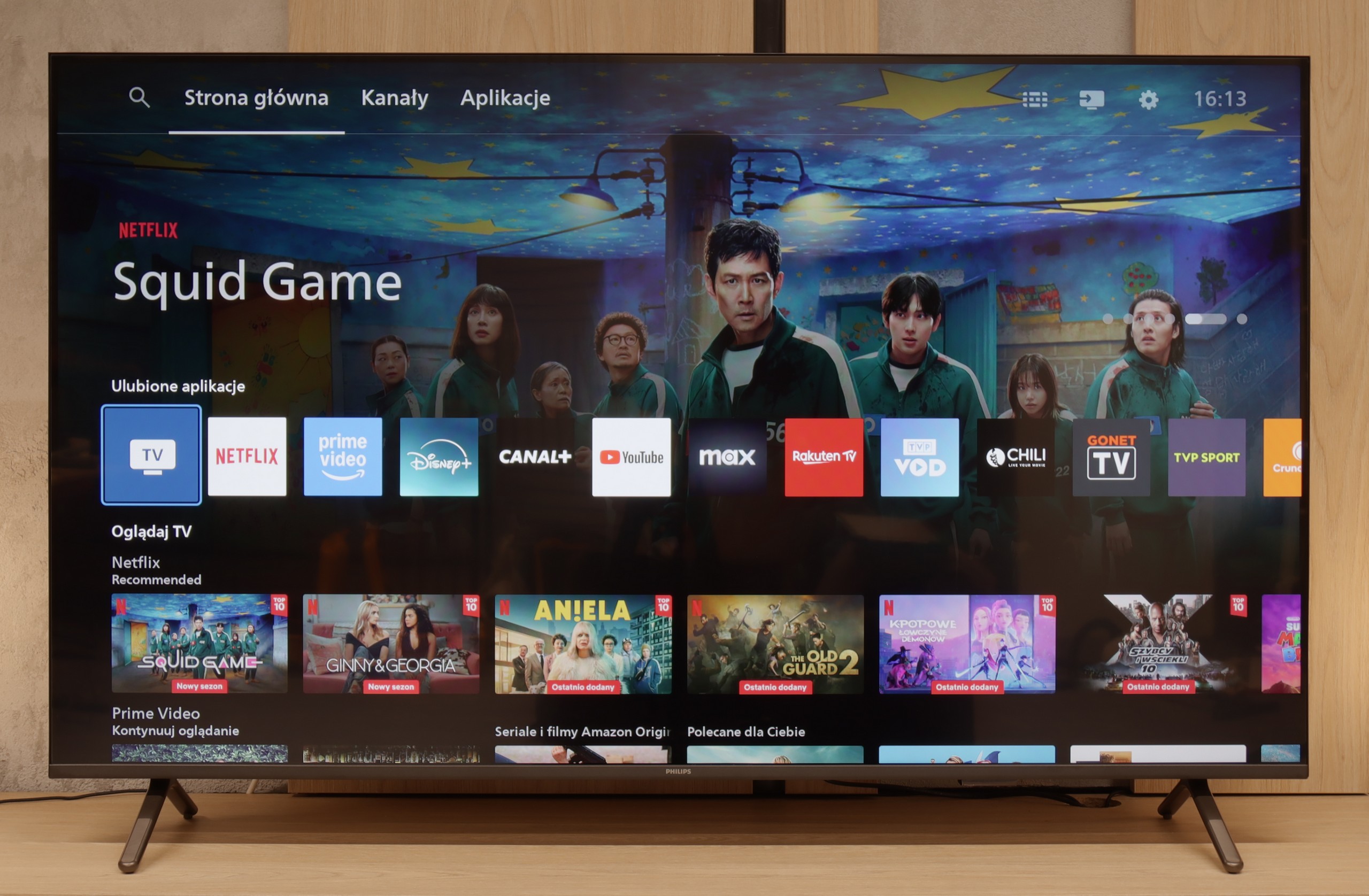
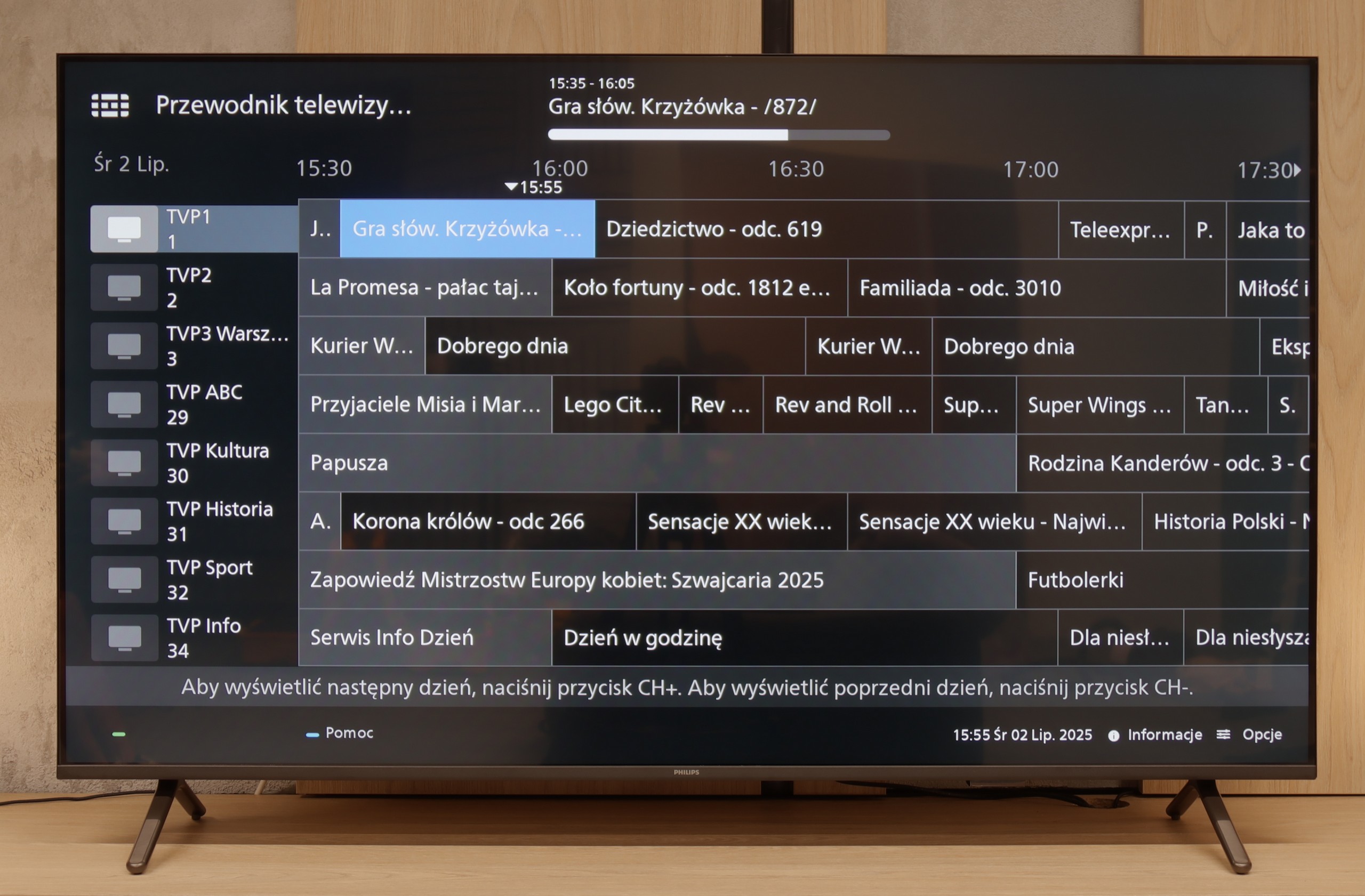
Sharp FQ8 is equipped with a modern Google TV system that provides access to a wide range of applications, such as Netflix, YouTube, Prime Video and Disney+. Additionally, the television supports voice control in Polish, making navigation and quick access to content easier. The FQ8 also offers the ability to connect multiple devices, such as keyboards, mice, Bluetooth headphones, and other accessories.
Despite these advantages, the television has certain limitations. The lack of television recording features and picture-in-picture (PiP) support may be a downside for those using these options. Additionally, Apple device users may feel the lack of compatibility with AirPlay, making it difficult to easily stream content from an iPhone or iPad to the television.
Classic TV Features:
If you are looking for a television that "works" in the most basic sense – the PUS8560 will fulfil that role. In terms of classic features, we have a rather minimalist set. On the plus side, there is an electronic programme guide (EPG), teletext, a backlit remote control with a classic numeric keypad, and a headphone jack input. It sounds a bit like a dream set for seniors – and there is some truth to that. However, it must be stated clearly: this is a television with very limited capabilities. We will not find recording functions from DVB tuners to USB here, nor is there a PiP mode or other conveniences known from more expensive models.
Smart TV:
How does the SmartTV perform on the PUS8560? Well, this is where it gets a bit more complicated. The PUS8560 runs on the Titan OS, which in this particular implementation posed significant problems. Some features, although present "on paper," simply did not work. For example: Wireless screen mirroring functions, such as Chromecast or Miracast – we tried to activate them from several different phones and laptops… without success. Perhaps this will be fixed in the future, but at the time of testing – it did not work. Additionally, the system's speed left much to be desired – switching between applications or home screens was simply slow. A considerable portion of the menu functions seems to be well hidden in the depths of a poorly organised system. To make matters worse, the library of available applications is quite limited. Even though the situation with applications is better than last year, it is still far from ideal. The situation tries to be salvaged by a modern remote – slim, elegant, backlit, and really well made. Unfortunately, it operates on classic infrared, so you have to aim it at the screen. The only exception is voice control, which works via Bluetooth… it’s just a pity that it doesn’t support Polish.
Playing files from USB
9.4/10
8/10
Supported photo formats:
Maximum photo resolution:

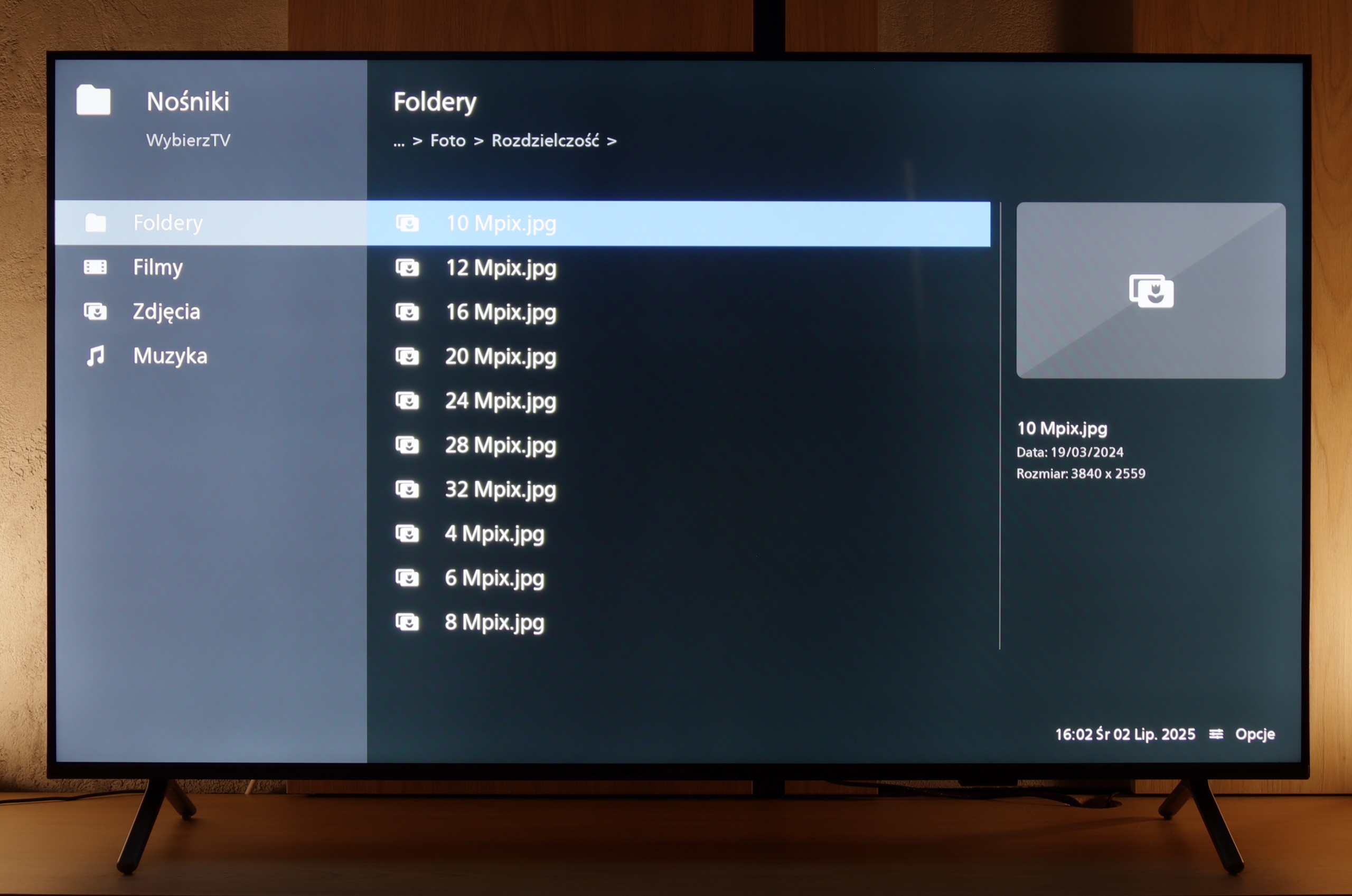
Thanks to the Google TV system, Sharp FQ8 offers great flexibility in playing files from USB. Users can install various applications for image and sound playback, such as VLC or MX Player, which enables the television to handle most popular file formats with ease. Whether it's movies, music, or photos, support for multiple formats ensures comfortable and hassle-free use of multimedia from external storage devices.
The PUS8560 handles the playback of most popular video and audio formats from a USB memory stick without any major issues, so there’s no point in detailing the compatibilities one by one. In everyday use, it should simply work – and it does. The only thing worth noting is the handling of images. Although the television easily recognises popular file extensions, there are instances when some images simply do not display when the graphic files have very high resolutions. This may not be a huge problem, but it’s good to keep it in mind, especially if we want to view photographs straight from the camera. Apart from that, the PUS8560 shouldn’t pose any significant issues with playing files from USB.
Apps
9.6/10
4.6/10














































Sound
6/10
6.2/10
- Subjective sound quality:6/106.2/10
- Dolby Digital Plus 7.1:
- Dolby True HD 7.1:
- Dolby Atmos in Dolby Digital Plus (JOC):
- Dolby Atmos in Dolby True HD:
- DTS:X in DTS-HD MA:
- DTS-HD Master Audio:
The sound assessment of the Sharp FQ8 is of course subjective, yet there are a few aspects worth highlighting. The television is equipped with a soundbar directed straight towards the user, branded by Harman/Kardon. Although it is not a full-fledged soundbar or home theatre system, the speaker arrangement clearly enhances the audio experience, delivering a clearer and more direct sound, which will certainly be a beneficial solution for everyday television viewing. It is also worth noting that the television was capable of achieving very high volume levels, which will definitely assist those who have some sort of hearing difficulty. The only remark we encountered was related to the sound processing by Dolby, which caused quite noticeable sound distortions and artificial clipping.
The television sounds quite pleasant and can confidently be regarded as having sufficient sound levels for most users – both for watching everyday programmes and for an evening viewing of a series. Moreover, a pleasant surprise is that even in this budget-friendly series, Philips has chosen to acquire licenses for full audio formats such as Dolby Atmos and DTS. This is great news for owners of home cinemas and soundbars, as it means full compatibility and no need to "fiddle around" with connecting external devices.


